Workplace Discrimination on the Basis of Gender - A Case Study on Marks & Spencer
VerifiedAdded on 2023/02/01
|33
|6870
|43
AI Summary
This research project explores workplace discrimination on the basis of gender, focusing on a case study of Marks & Spencer. It examines the impact of discrimination on employee turnover and performance, identifies issues arising from gender discrimination, discusses the benefits of implementing laws and policies related to discrimination, and suggests strategies to reduce discrimination in the organization.
Contribute Materials
Your contribution can guide someone’s learning journey. Share your
documents today.

RESEARCH PROJECT
Secure Best Marks with AI Grader
Need help grading? Try our AI Grader for instant feedback on your assignments.
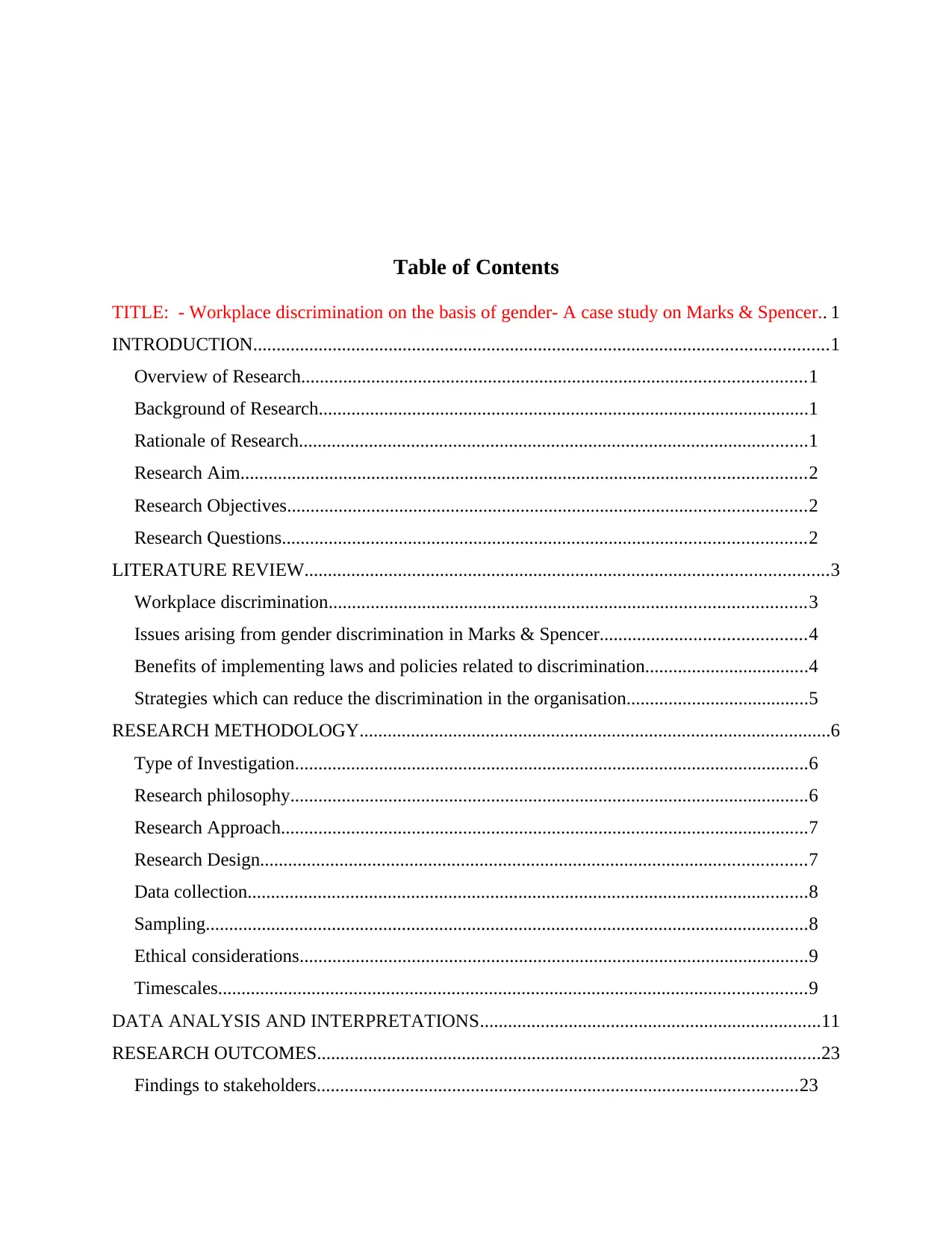
Table of Contents
TITLE: - Workplace discrimination on the basis of gender- A case study on Marks & Spencer.. 1
INTRODUCTION...........................................................................................................................1
Overview of Research............................................................................................................1
Background of Research.........................................................................................................1
Rationale of Research.............................................................................................................1
Research Aim.........................................................................................................................2
Research Objectives...............................................................................................................2
Research Questions................................................................................................................2
LITERATURE REVIEW................................................................................................................3
Workplace discrimination......................................................................................................3
Issues arising from gender discrimination in Marks & Spencer............................................4
Benefits of implementing laws and policies related to discrimination...................................4
Strategies which can reduce the discrimination in the organisation.......................................5
RESEARCH METHODOLOGY.....................................................................................................6
Type of Investigation..............................................................................................................6
Research philosophy...............................................................................................................6
Research Approach.................................................................................................................7
Research Design.....................................................................................................................7
Data collection........................................................................................................................8
Sampling.................................................................................................................................8
Ethical considerations.............................................................................................................9
Timescales..............................................................................................................................9
DATA ANALYSIS AND INTERPRETATIONS.........................................................................11
RESEARCH OUTCOMES............................................................................................................23
Findings to stakeholders.......................................................................................................23
TITLE: - Workplace discrimination on the basis of gender- A case study on Marks & Spencer.. 1
INTRODUCTION...........................................................................................................................1
Overview of Research............................................................................................................1
Background of Research.........................................................................................................1
Rationale of Research.............................................................................................................1
Research Aim.........................................................................................................................2
Research Objectives...............................................................................................................2
Research Questions................................................................................................................2
LITERATURE REVIEW................................................................................................................3
Workplace discrimination......................................................................................................3
Issues arising from gender discrimination in Marks & Spencer............................................4
Benefits of implementing laws and policies related to discrimination...................................4
Strategies which can reduce the discrimination in the organisation.......................................5
RESEARCH METHODOLOGY.....................................................................................................6
Type of Investigation..............................................................................................................6
Research philosophy...............................................................................................................6
Research Approach.................................................................................................................7
Research Design.....................................................................................................................7
Data collection........................................................................................................................8
Sampling.................................................................................................................................8
Ethical considerations.............................................................................................................9
Timescales..............................................................................................................................9
DATA ANALYSIS AND INTERPRETATIONS.........................................................................11
RESEARCH OUTCOMES............................................................................................................23
Findings to stakeholders.......................................................................................................23
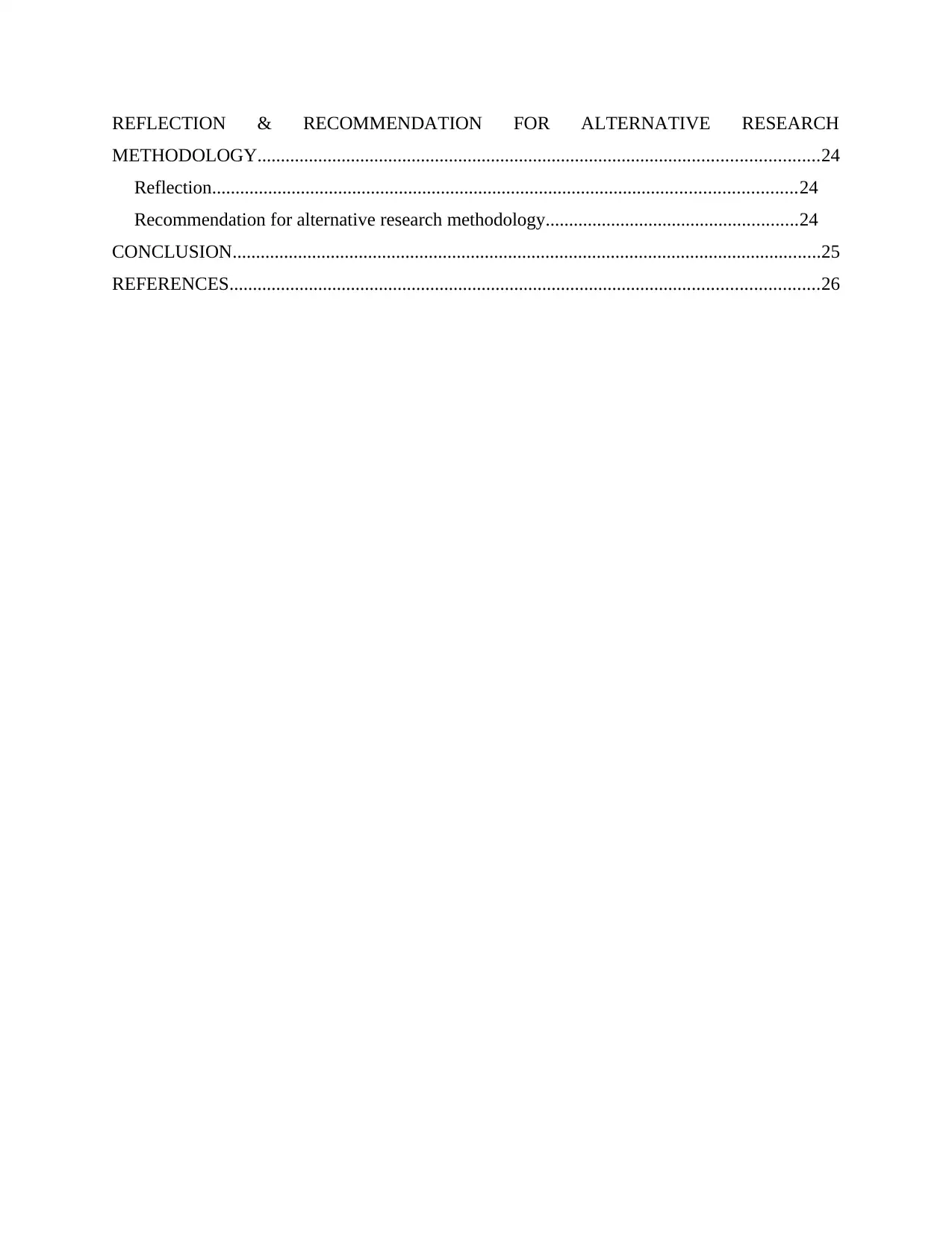
REFLECTION & RECOMMENDATION FOR ALTERNATIVE RESEARCH
METHODOLOGY........................................................................................................................24
Reflection.............................................................................................................................24
Recommendation for alternative research methodology......................................................24
CONCLUSION..............................................................................................................................25
REFERENCES..............................................................................................................................26
METHODOLOGY........................................................................................................................24
Reflection.............................................................................................................................24
Recommendation for alternative research methodology......................................................24
CONCLUSION..............................................................................................................................25
REFERENCES..............................................................................................................................26

TITLE: - Workplace discrimination on the basis of gender- A case study on
Marks & Spencer.
INTRODUCTION
Overview of Research
The workplace discrimination occurs when a person is discriminated adversely against
because of number of the factors. At workplace, discrimination can be costly and may negatively
impact on reputation of company (Abadeer, 2015). Discrimination is based on the prejudices and
in this employee is treated in unfavourable manner on the basis of race, gender, pregnancy,
disability and others. Present report consists the gender discrimination related issues. Gender
discrimination can take the different forms at workplace and legislation applies to women and
men both. It arises when a company treats employee differently because a person is woman or
man.
Background of Research
Discrimination at workplace result in reinforced the inequalities and reduces morale of
employees. This negatively influence on productivity and profitability of company. Impacts are
not only develops physical impact but also mental can affect on employee performance. The
perceived discrimination has impact on employee as well as working environment. Marks &
Spencer is retail company that mainly provides clothing, home products, grocery items and
others (Antman, 2015). This company has admitted to pay the average female employee around
12.3% less than average male employees which attributing pay gap. This reduced the morale as
well as motivational level of female employees and these impact on organisational productivity.
Other than this, there is a difference in bonus paid to female and male employee was 53.4% with
75% of female staff receiving bonus as comparisons with 66% men.
Rationale of Research
Present research is taken in to consideration on impact of workplace discrimination on
employee turnover and performance. The researcher conducts investigation in personal and
professional context. In context to personal manner, skills and understanding of a learner
enhanced so that any kind of issue will not be arise in conducting an investigation (Baah-
Boateng, 2012). In professional context, researcher can enhance regarding the workplace
Marks & Spencer.
INTRODUCTION
Overview of Research
The workplace discrimination occurs when a person is discriminated adversely against
because of number of the factors. At workplace, discrimination can be costly and may negatively
impact on reputation of company (Abadeer, 2015). Discrimination is based on the prejudices and
in this employee is treated in unfavourable manner on the basis of race, gender, pregnancy,
disability and others. Present report consists the gender discrimination related issues. Gender
discrimination can take the different forms at workplace and legislation applies to women and
men both. It arises when a company treats employee differently because a person is woman or
man.
Background of Research
Discrimination at workplace result in reinforced the inequalities and reduces morale of
employees. This negatively influence on productivity and profitability of company. Impacts are
not only develops physical impact but also mental can affect on employee performance. The
perceived discrimination has impact on employee as well as working environment. Marks &
Spencer is retail company that mainly provides clothing, home products, grocery items and
others (Antman, 2015). This company has admitted to pay the average female employee around
12.3% less than average male employees which attributing pay gap. This reduced the morale as
well as motivational level of female employees and these impact on organisational productivity.
Other than this, there is a difference in bonus paid to female and male employee was 53.4% with
75% of female staff receiving bonus as comparisons with 66% men.
Rationale of Research
Present research is taken in to consideration on impact of workplace discrimination on
employee turnover and performance. The researcher conducts investigation in personal and
professional context. In context to personal manner, skills and understanding of a learner
enhanced so that any kind of issue will not be arise in conducting an investigation (Baah-
Boateng, 2012). In professional context, researcher can enhance regarding the workplace
Secure Best Marks with AI Grader
Need help grading? Try our AI Grader for instant feedback on your assignments.
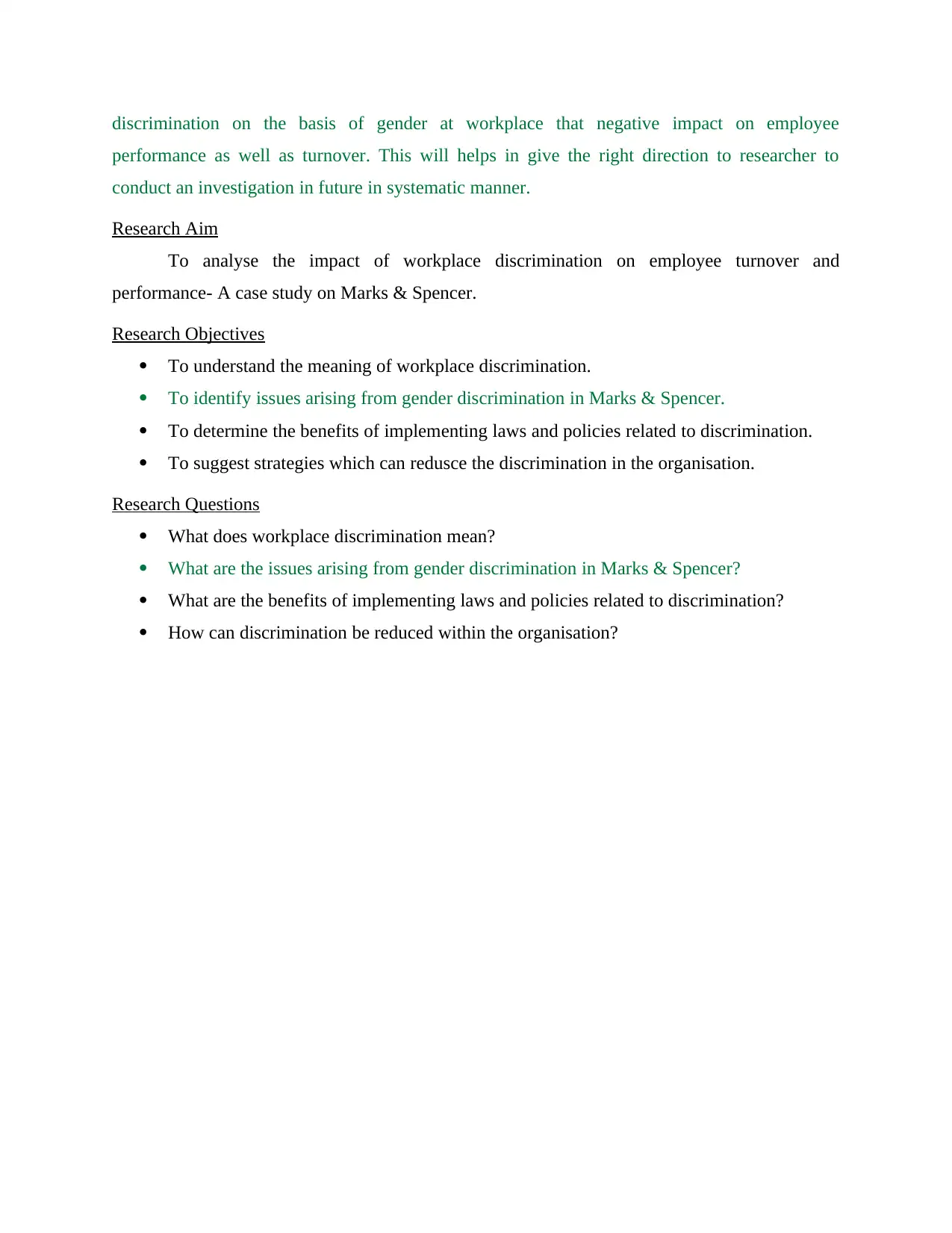
discrimination on the basis of gender at workplace that negative impact on employee
performance as well as turnover. This will helps in give the right direction to researcher to
conduct an investigation in future in systematic manner.
Research Aim
To analyse the impact of workplace discrimination on employee turnover and
performance- A case study on Marks & Spencer.
Research Objectives
To understand the meaning of workplace discrimination.
To identify issues arising from gender discrimination in Marks & Spencer.
To determine the benefits of implementing laws and policies related to discrimination.
To suggest strategies which can redusce the discrimination in the organisation.
Research Questions
What does workplace discrimination mean?
What are the issues arising from gender discrimination in Marks & Spencer?
What are the benefits of implementing laws and policies related to discrimination?
How can discrimination be reduced within the organisation?
performance as well as turnover. This will helps in give the right direction to researcher to
conduct an investigation in future in systematic manner.
Research Aim
To analyse the impact of workplace discrimination on employee turnover and
performance- A case study on Marks & Spencer.
Research Objectives
To understand the meaning of workplace discrimination.
To identify issues arising from gender discrimination in Marks & Spencer.
To determine the benefits of implementing laws and policies related to discrimination.
To suggest strategies which can redusce the discrimination in the organisation.
Research Questions
What does workplace discrimination mean?
What are the issues arising from gender discrimination in Marks & Spencer?
What are the benefits of implementing laws and policies related to discrimination?
How can discrimination be reduced within the organisation?

LITERATURE REVIEW
Literature review, also known as narrative review which includes the current
understanding and knowledge of the researcher with respect to the topic. It is pure theoretical
knowledge. Literature review does not include new report or original experiments. It consists of
secondary research, it takes the information from sources which are already available at many
platforms (Barthelemy, McCormick and Henderson, 2016). Such platforms include- author’s
books and journals, articles and so forth. It is a synopsis of your total research study. The
literature presented here are organised in a proper way. It also tells about how your project is
linked with prior researches done before and how it will contribute more in it.
Workplace discrimination
According to opinion of Sarah Benstead (2020) Work discrimination refers to the
inequality done in work place. It is a form of discrimination done with employees based on race,
gender, religion, pay, physical or mental disability, caste, skin colour, national origin or age. The
problem of work discrimination can be found in majority of organisations where one or other
employee does suffer from such discrimination.
Types of work discrimination
Sexual harassment- Sexual harassment is the inappropriate verbal or physical sexual
advancements or request for sexual favours done with employee.
Disability- Discrimination also done with the people who are physically or mentally
challenged. They firstly do not prefer to hire such people or if they hire they don not give much
importance to them which makes them feel inferior. Issues arising from gender discrimination in
Marks & Spencer
Pay scale- In many organisations the pay scale paid to men and women differentiates.
The pay scale paid to men is comparatively high to the pay of women even if both man and
women are on same position and does the same work. Such discrimination decreases the
motivation of woman who is same passionate towards his work as men are (Chen and et. al.,
2013).
Religion & caste- Organisations do performs discrimination towards their employees
with respect of their caste and religion they belong to.
Literature review, also known as narrative review which includes the current
understanding and knowledge of the researcher with respect to the topic. It is pure theoretical
knowledge. Literature review does not include new report or original experiments. It consists of
secondary research, it takes the information from sources which are already available at many
platforms (Barthelemy, McCormick and Henderson, 2016). Such platforms include- author’s
books and journals, articles and so forth. It is a synopsis of your total research study. The
literature presented here are organised in a proper way. It also tells about how your project is
linked with prior researches done before and how it will contribute more in it.
Workplace discrimination
According to opinion of Sarah Benstead (2020) Work discrimination refers to the
inequality done in work place. It is a form of discrimination done with employees based on race,
gender, religion, pay, physical or mental disability, caste, skin colour, national origin or age. The
problem of work discrimination can be found in majority of organisations where one or other
employee does suffer from such discrimination.
Types of work discrimination
Sexual harassment- Sexual harassment is the inappropriate verbal or physical sexual
advancements or request for sexual favours done with employee.
Disability- Discrimination also done with the people who are physically or mentally
challenged. They firstly do not prefer to hire such people or if they hire they don not give much
importance to them which makes them feel inferior. Issues arising from gender discrimination in
Marks & Spencer
Pay scale- In many organisations the pay scale paid to men and women differentiates.
The pay scale paid to men is comparatively high to the pay of women even if both man and
women are on same position and does the same work. Such discrimination decreases the
motivation of woman who is same passionate towards his work as men are (Chen and et. al.,
2013).
Religion & caste- Organisations do performs discrimination towards their employees
with respect of their caste and religion they belong to.
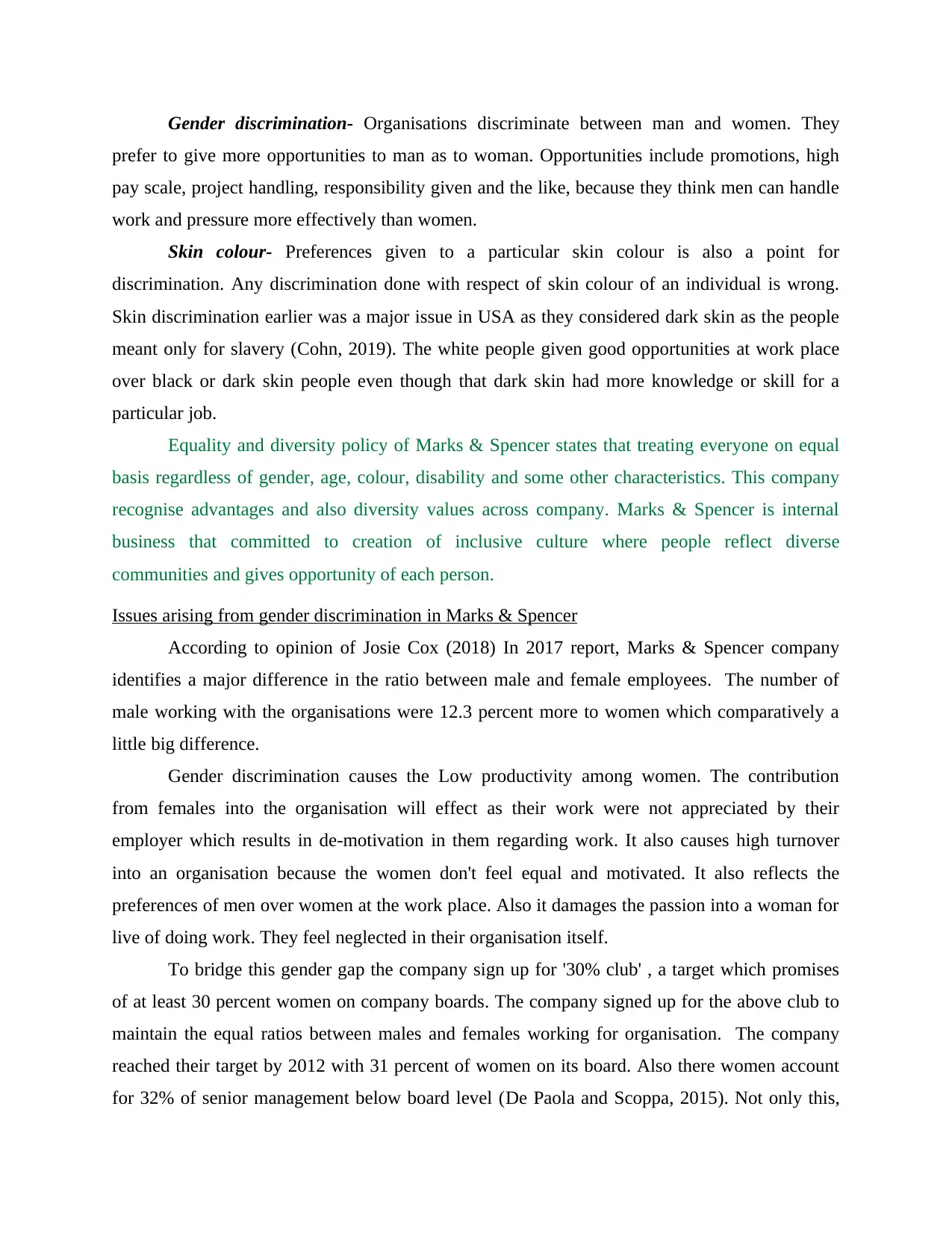
Gender discrimination- Organisations discriminate between man and women. They
prefer to give more opportunities to man as to woman. Opportunities include promotions, high
pay scale, project handling, responsibility given and the like, because they think men can handle
work and pressure more effectively than women.
Skin colour- Preferences given to a particular skin colour is also a point for
discrimination. Any discrimination done with respect of skin colour of an individual is wrong.
Skin discrimination earlier was a major issue in USA as they considered dark skin as the people
meant only for slavery (Cohn, 2019). The white people given good opportunities at work place
over black or dark skin people even though that dark skin had more knowledge or skill for a
particular job.
Equality and diversity policy of Marks & Spencer states that treating everyone on equal
basis regardless of gender, age, colour, disability and some other characteristics. This company
recognise advantages and also diversity values across company. Marks & Spencer is internal
business that committed to creation of inclusive culture where people reflect diverse
communities and gives opportunity of each person.
Issues arising from gender discrimination in Marks & Spencer
According to opinion of Josie Cox (2018) In 2017 report, Marks & Spencer company
identifies a major difference in the ratio between male and female employees. The number of
male working with the organisations were 12.3 percent more to women which comparatively a
little big difference.
Gender discrimination causes the Low productivity among women. The contribution
from females into the organisation will effect as their work were not appreciated by their
employer which results in de-motivation in them regarding work. It also causes high turnover
into an organisation because the women don't feel equal and motivated. It also reflects the
preferences of men over women at the work place. Also it damages the passion into a woman for
live of doing work. They feel neglected in their organisation itself.
To bridge this gender gap the company sign up for '30% club' , a target which promises
of at least 30 percent women on company boards. The company signed up for the above club to
maintain the equal ratios between males and females working for organisation. The company
reached their target by 2012 with 31 percent of women on its board. Also there women account
for 32% of senior management below board level (De Paola and Scoppa, 2015). Not only this,
prefer to give more opportunities to man as to woman. Opportunities include promotions, high
pay scale, project handling, responsibility given and the like, because they think men can handle
work and pressure more effectively than women.
Skin colour- Preferences given to a particular skin colour is also a point for
discrimination. Any discrimination done with respect of skin colour of an individual is wrong.
Skin discrimination earlier was a major issue in USA as they considered dark skin as the people
meant only for slavery (Cohn, 2019). The white people given good opportunities at work place
over black or dark skin people even though that dark skin had more knowledge or skill for a
particular job.
Equality and diversity policy of Marks & Spencer states that treating everyone on equal
basis regardless of gender, age, colour, disability and some other characteristics. This company
recognise advantages and also diversity values across company. Marks & Spencer is internal
business that committed to creation of inclusive culture where people reflect diverse
communities and gives opportunity of each person.
Issues arising from gender discrimination in Marks & Spencer
According to opinion of Josie Cox (2018) In 2017 report, Marks & Spencer company
identifies a major difference in the ratio between male and female employees. The number of
male working with the organisations were 12.3 percent more to women which comparatively a
little big difference.
Gender discrimination causes the Low productivity among women. The contribution
from females into the organisation will effect as their work were not appreciated by their
employer which results in de-motivation in them regarding work. It also causes high turnover
into an organisation because the women don't feel equal and motivated. It also reflects the
preferences of men over women at the work place. Also it damages the passion into a woman for
live of doing work. They feel neglected in their organisation itself.
To bridge this gender gap the company sign up for '30% club' , a target which promises
of at least 30 percent women on company boards. The company signed up for the above club to
maintain the equal ratios between males and females working for organisation. The company
reached their target by 2012 with 31 percent of women on its board. Also there women account
for 32% of senior management below board level (De Paola and Scoppa, 2015). Not only this,
Paraphrase This Document
Need a fresh take? Get an instant paraphrase of this document with our AI Paraphraser

the company encourages women for promotions and also consider them suitable for senior
positions.
Benefits of implementing laws and policies related to discrimination
As per opinion of Marie-Anne Valfort (2020) Combating the discrimination needs
combining strengths of anti- discrimination related policies to addressing weaknesses. Anti
discrimination laws are mainly designed to prevent the discrimination against specific groups of
the people. These are rooted in the equality principles and should not treated because of
characteristic. Through implementing the discrimination legislation at workplace, discrimination
will be reduced and everyone in company can able to perform in a better manner. On the other
hand, equal pay act needs the managers to provide women and men equal pay for the equal work.
The staff members so the equal work when they are able to perform in better manner in same
working situations, responsibilities and efforts. With the help of implementing this act, male and
female employees can work well and they will focus on attaining the specific objectives within
given time period (De Marco, 2012).
Strategies which can reduce the discrimination in the organisation
According to Tony Jeanetta (2019), Managers should provide the equal opportunities to
employees so that they can work effectively and focus on attaining the specific activities. To
reduction in discrimination at workplace helps in reduce confusion and uncertainty between
managers and employees by providing them safe working environment. There is different ways
Marks & Spencer company use to reduce the discrimination from workplace:
Educate- Under this, there is a need to Marks & Spencer to give the inclusion and
diversity related training for staff members. This is necessary that all staff members should know
what arise gender discrimination. It can be on the basis of job responsibilities, promotions etc.
This is essential for company to prevent the racism through cultivating the respect as the
organisational values.
Communicate- It is required for company to encourage the open communication to make
the employees comfortable and discuss the concerned with HR, supervisors at workplace.
Through this, employee will feel better and able to interact with each other (Delavande and
Zafar, 2013).
Build Diversity from the Inside Out- Marks & Spencer company eliminated the
experience needed from job postings. This kind of process is helpful in motivate the qualified
positions.
Benefits of implementing laws and policies related to discrimination
As per opinion of Marie-Anne Valfort (2020) Combating the discrimination needs
combining strengths of anti- discrimination related policies to addressing weaknesses. Anti
discrimination laws are mainly designed to prevent the discrimination against specific groups of
the people. These are rooted in the equality principles and should not treated because of
characteristic. Through implementing the discrimination legislation at workplace, discrimination
will be reduced and everyone in company can able to perform in a better manner. On the other
hand, equal pay act needs the managers to provide women and men equal pay for the equal work.
The staff members so the equal work when they are able to perform in better manner in same
working situations, responsibilities and efforts. With the help of implementing this act, male and
female employees can work well and they will focus on attaining the specific objectives within
given time period (De Marco, 2012).
Strategies which can reduce the discrimination in the organisation
According to Tony Jeanetta (2019), Managers should provide the equal opportunities to
employees so that they can work effectively and focus on attaining the specific activities. To
reduction in discrimination at workplace helps in reduce confusion and uncertainty between
managers and employees by providing them safe working environment. There is different ways
Marks & Spencer company use to reduce the discrimination from workplace:
Educate- Under this, there is a need to Marks & Spencer to give the inclusion and
diversity related training for staff members. This is necessary that all staff members should know
what arise gender discrimination. It can be on the basis of job responsibilities, promotions etc.
This is essential for company to prevent the racism through cultivating the respect as the
organisational values.
Communicate- It is required for company to encourage the open communication to make
the employees comfortable and discuss the concerned with HR, supervisors at workplace.
Through this, employee will feel better and able to interact with each other (Delavande and
Zafar, 2013).
Build Diversity from the Inside Out- Marks & Spencer company eliminated the
experience needed from job postings. This kind of process is helpful in motivate the qualified

female employees to be applied so that the working environment can be developed properly and
each one can work in significant manner.
each one can work in significant manner.

RESEARCH METHODOLOGY
Research methodology is the procedure a researcher has followed with respect to data
collection. It tells the reader about how the data has been collected or generated. It also describes
the approaches and design which has been used majorly in the study. Research methodology tells
a reader about how the study has been conducted, what sources of information he used, and how
the study has been perceived (Kumar, 2019).
Type of Investigation
In conducting the present investigation, qualitative method has been used because it
analyse the collected data effectively so that the researcher can able to getting the positive
outcomes.
Different research methods are mention below-
Qualitative method- It is a research method where the data is gathered through
observation and self-conduct research. In this type of data the information collected is qualitative
in nature i.e. they are expressed in non-numerical terms. From this method generally the
behaviour and perception of target group is perceived. If the researcher wants to know about the
taste, preferences, attitude, stimuli and the like of his target audience about a particular topic then
this method is used (Hennink, Hutter and Bailey, 2020). Some commonly used primary method
of research includes observation, interview, experiments, surveys etc.
Quantitative method- Under this, information and data are gathered in numerical form.
All the information and data are quantifiable. The data which is gathered then get organized and
analysis takes place to take out meaning interpretation from them. Such interpretation helps the
investigator in getting to a conclusion (Bernard, 2017).
Research philosophy
In present research, interpretivism philosophy has been used because this helps in analyse
opinions and viewpoints of different investigators. This philosophy is helpful in getting detailed
information and providing positive outcomes (Cazeaux, 2017).
This is explained as the beliefs and belief framework about knowledge development. The
conceptual methods make it possible to assess which philosophy should be pursued by a
Research methodology is the procedure a researcher has followed with respect to data
collection. It tells the reader about how the data has been collected or generated. It also describes
the approaches and design which has been used majorly in the study. Research methodology tells
a reader about how the study has been conducted, what sources of information he used, and how
the study has been perceived (Kumar, 2019).
Type of Investigation
In conducting the present investigation, qualitative method has been used because it
analyse the collected data effectively so that the researcher can able to getting the positive
outcomes.
Different research methods are mention below-
Qualitative method- It is a research method where the data is gathered through
observation and self-conduct research. In this type of data the information collected is qualitative
in nature i.e. they are expressed in non-numerical terms. From this method generally the
behaviour and perception of target group is perceived. If the researcher wants to know about the
taste, preferences, attitude, stimuli and the like of his target audience about a particular topic then
this method is used (Hennink, Hutter and Bailey, 2020). Some commonly used primary method
of research includes observation, interview, experiments, surveys etc.
Quantitative method- Under this, information and data are gathered in numerical form.
All the information and data are quantifiable. The data which is gathered then get organized and
analysis takes place to take out meaning interpretation from them. Such interpretation helps the
investigator in getting to a conclusion (Bernard, 2017).
Research philosophy
In present research, interpretivism philosophy has been used because this helps in analyse
opinions and viewpoints of different investigators. This philosophy is helpful in getting detailed
information and providing positive outcomes (Cazeaux, 2017).
This is explained as the beliefs and belief framework about knowledge development. The
conceptual methods make it possible to assess which philosophy should be pursued by a
Secure Best Marks with AI Grader
Need help grading? Try our AI Grader for instant feedback on your assignments.
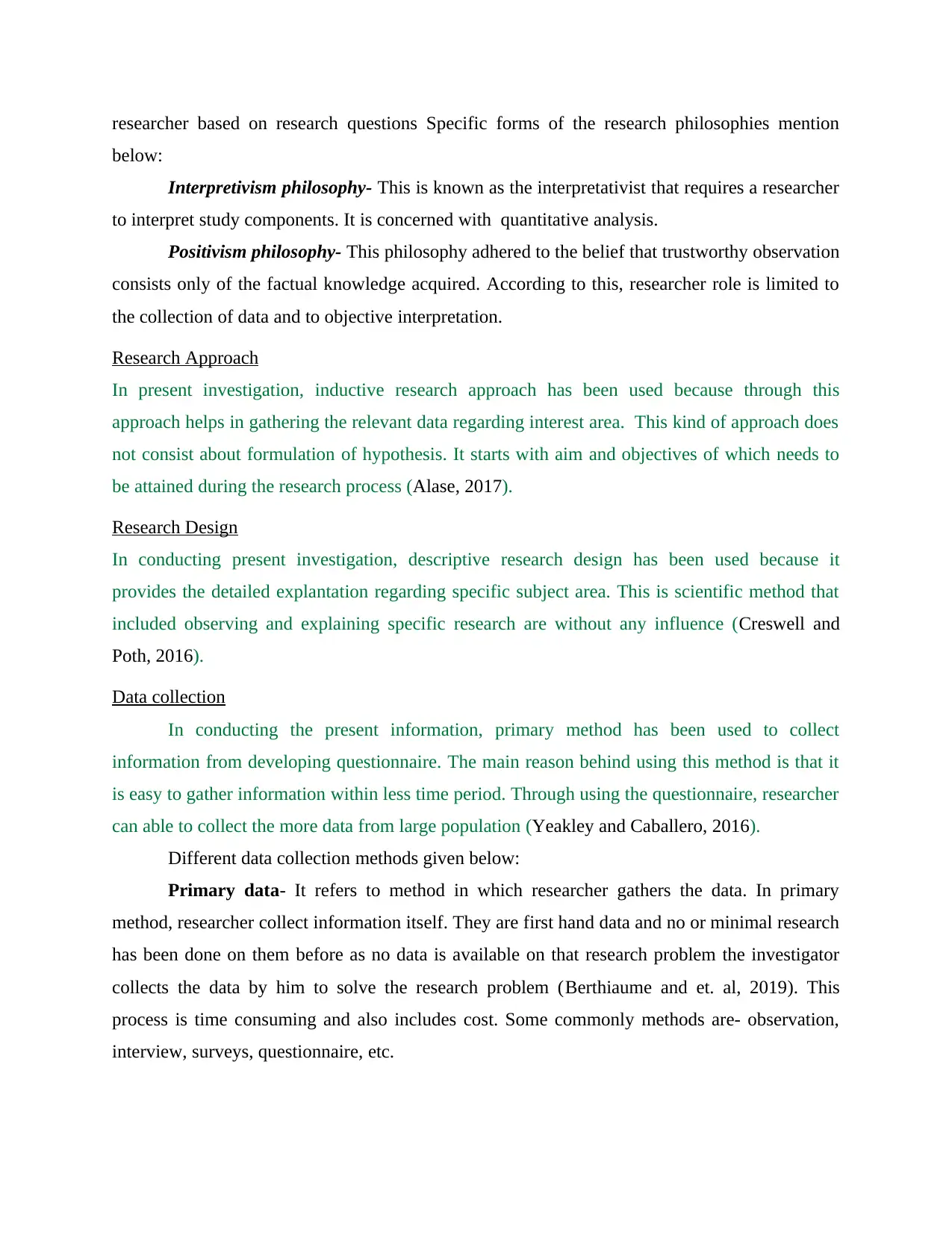
researcher based on research questions Specific forms of the research philosophies mention
below:
Interpretivism philosophy- This is known as the interpretativist that requires a researcher
to interpret study components. It is concerned with quantitative analysis.
Positivism philosophy- This philosophy adhered to the belief that trustworthy observation
consists only of the factual knowledge acquired. According to this, researcher role is limited to
the collection of data and to objective interpretation.
Research Approach
In present investigation, inductive research approach has been used because through this
approach helps in gathering the relevant data regarding interest area. This kind of approach does
not consist about formulation of hypothesis. It starts with aim and objectives of which needs to
be attained during the research process (Alase, 2017).
Research Design
In conducting present investigation, descriptive research design has been used because it
provides the detailed explantation regarding specific subject area. This is scientific method that
included observing and explaining specific research are without any influence (Creswell and
Poth, 2016).
Data collection
In conducting the present information, primary method has been used to collect
information from developing questionnaire. The main reason behind using this method is that it
is easy to gather information within less time period. Through using the questionnaire, researcher
can able to collect the more data from large population (Yeakley and Caballero, 2016).
Different data collection methods given below:
Primary data- It refers to method in which researcher gathers the data. In primary
method, researcher collect information itself. They are first hand data and no or minimal research
has been done on them before as no data is available on that research problem the investigator
collects the data by him to solve the research problem (Berthiaume and et. al, 2019). This
process is time consuming and also includes cost. Some commonly methods are- observation,
interview, surveys, questionnaire, etc.
below:
Interpretivism philosophy- This is known as the interpretativist that requires a researcher
to interpret study components. It is concerned with quantitative analysis.
Positivism philosophy- This philosophy adhered to the belief that trustworthy observation
consists only of the factual knowledge acquired. According to this, researcher role is limited to
the collection of data and to objective interpretation.
Research Approach
In present investigation, inductive research approach has been used because through this
approach helps in gathering the relevant data regarding interest area. This kind of approach does
not consist about formulation of hypothesis. It starts with aim and objectives of which needs to
be attained during the research process (Alase, 2017).
Research Design
In conducting present investigation, descriptive research design has been used because it
provides the detailed explantation regarding specific subject area. This is scientific method that
included observing and explaining specific research are without any influence (Creswell and
Poth, 2016).
Data collection
In conducting the present information, primary method has been used to collect
information from developing questionnaire. The main reason behind using this method is that it
is easy to gather information within less time period. Through using the questionnaire, researcher
can able to collect the more data from large population (Yeakley and Caballero, 2016).
Different data collection methods given below:
Primary data- It refers to method in which researcher gathers the data. In primary
method, researcher collect information itself. They are first hand data and no or minimal research
has been done on them before as no data is available on that research problem the investigator
collects the data by him to solve the research problem (Berthiaume and et. al, 2019). This
process is time consuming and also includes cost. Some commonly methods are- observation,
interview, surveys, questionnaire, etc.
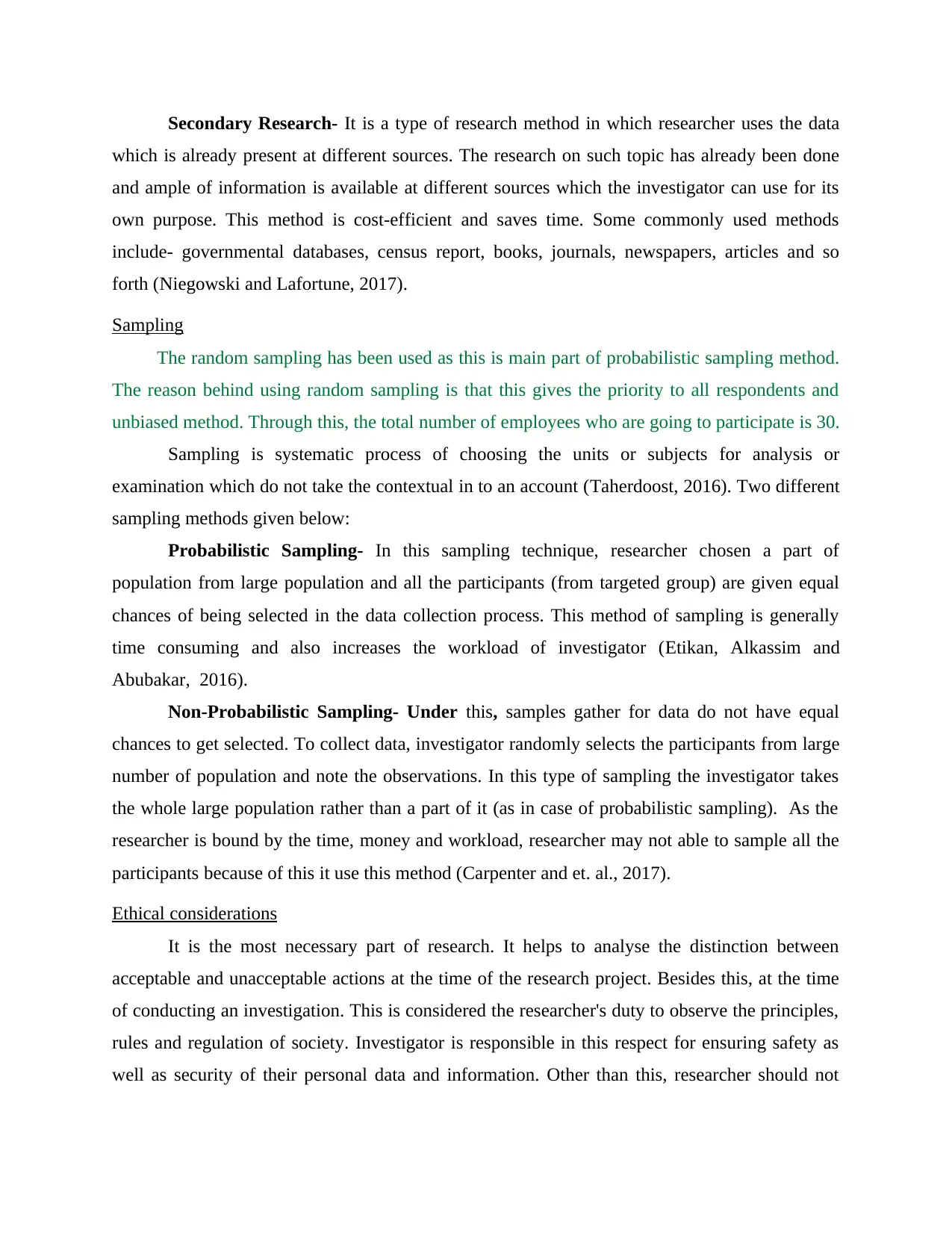
Secondary Research- It is a type of research method in which researcher uses the data
which is already present at different sources. The research on such topic has already been done
and ample of information is available at different sources which the investigator can use for its
own purpose. This method is cost-efficient and saves time. Some commonly used methods
include- governmental databases, census report, books, journals, newspapers, articles and so
forth (Niegowski and Lafortune, 2017).
Sampling
The random sampling has been used as this is main part of probabilistic sampling method.
The reason behind using random sampling is that this gives the priority to all respondents and
unbiased method. Through this, the total number of employees who are going to participate is 30.
Sampling is systematic process of choosing the units or subjects for analysis or
examination which do not take the contextual in to an account (Taherdoost, 2016). Two different
sampling methods given below:
Probabilistic Sampling- In this sampling technique, researcher chosen a part of
population from large population and all the participants (from targeted group) are given equal
chances of being selected in the data collection process. This method of sampling is generally
time consuming and also increases the workload of investigator (Etikan, Alkassim and
Abubakar, 2016).
Non-Probabilistic Sampling- Under this, samples gather for data do not have equal
chances to get selected. To collect data, investigator randomly selects the participants from large
number of population and note the observations. In this type of sampling the investigator takes
the whole large population rather than a part of it (as in case of probabilistic sampling). As the
researcher is bound by the time, money and workload, researcher may not able to sample all the
participants because of this it use this method (Carpenter and et. al., 2017).
Ethical considerations
It is the most necessary part of research. It helps to analyse the distinction between
acceptable and unacceptable actions at the time of the research project. Besides this, at the time
of conducting an investigation. This is considered the researcher's duty to observe the principles,
rules and regulation of society. Investigator is responsible in this respect for ensuring safety as
well as security of their personal data and information. Other than this, researcher should not
which is already present at different sources. The research on such topic has already been done
and ample of information is available at different sources which the investigator can use for its
own purpose. This method is cost-efficient and saves time. Some commonly used methods
include- governmental databases, census report, books, journals, newspapers, articles and so
forth (Niegowski and Lafortune, 2017).
Sampling
The random sampling has been used as this is main part of probabilistic sampling method.
The reason behind using random sampling is that this gives the priority to all respondents and
unbiased method. Through this, the total number of employees who are going to participate is 30.
Sampling is systematic process of choosing the units or subjects for analysis or
examination which do not take the contextual in to an account (Taherdoost, 2016). Two different
sampling methods given below:
Probabilistic Sampling- In this sampling technique, researcher chosen a part of
population from large population and all the participants (from targeted group) are given equal
chances of being selected in the data collection process. This method of sampling is generally
time consuming and also increases the workload of investigator (Etikan, Alkassim and
Abubakar, 2016).
Non-Probabilistic Sampling- Under this, samples gather for data do not have equal
chances to get selected. To collect data, investigator randomly selects the participants from large
number of population and note the observations. In this type of sampling the investigator takes
the whole large population rather than a part of it (as in case of probabilistic sampling). As the
researcher is bound by the time, money and workload, researcher may not able to sample all the
participants because of this it use this method (Carpenter and et. al., 2017).
Ethical considerations
It is the most necessary part of research. It helps to analyse the distinction between
acceptable and unacceptable actions at the time of the research project. Besides this, at the time
of conducting an investigation. This is considered the researcher's duty to observe the principles,
rules and regulation of society. Investigator is responsible in this respect for ensuring safety as
well as security of their personal data and information. Other than this, researcher should not
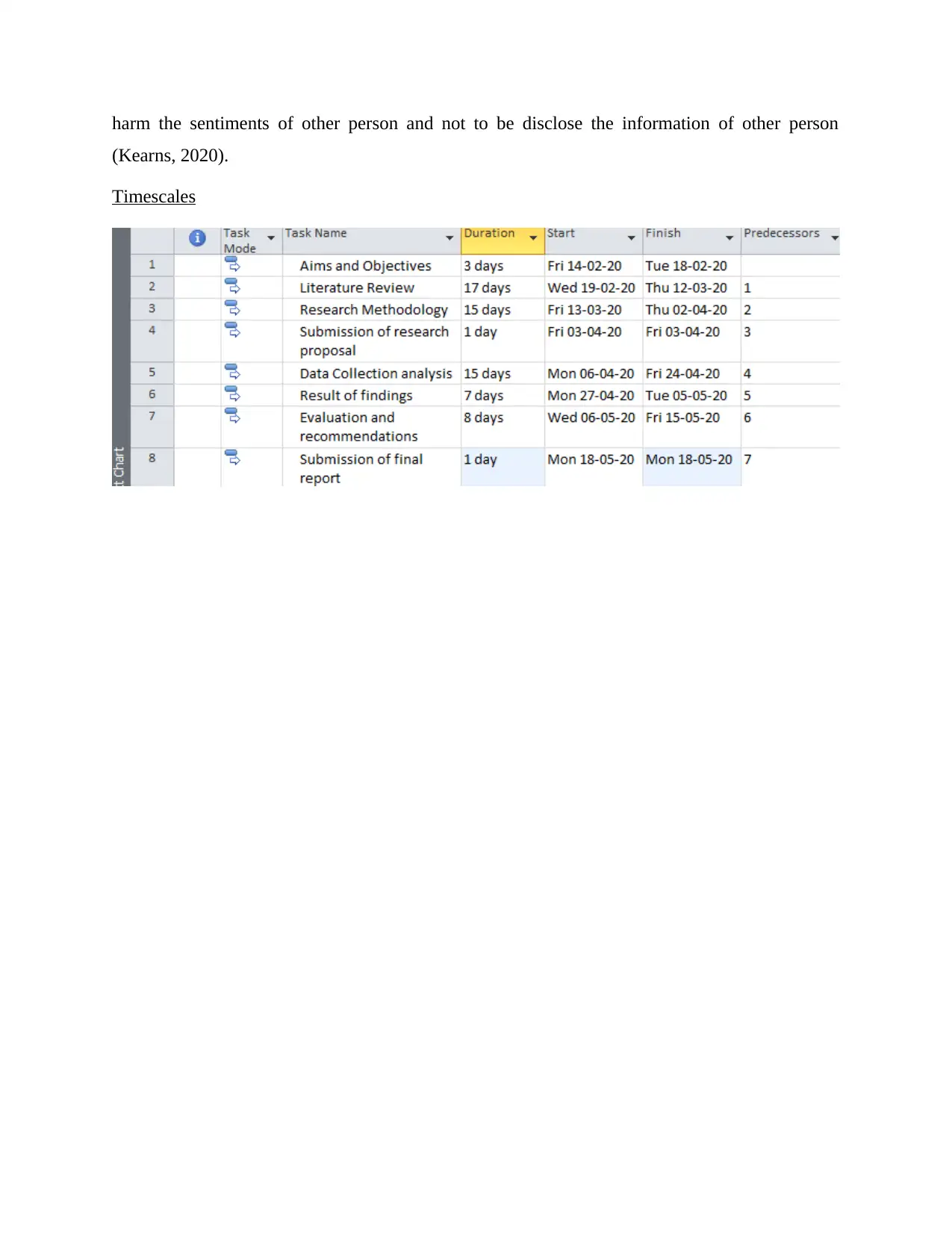
harm the sentiments of other person and not to be disclose the information of other person
(Kearns, 2020).
Timescales
(Kearns, 2020).
Timescales
Paraphrase This Document
Need a fresh take? Get an instant paraphrase of this document with our AI Paraphraser
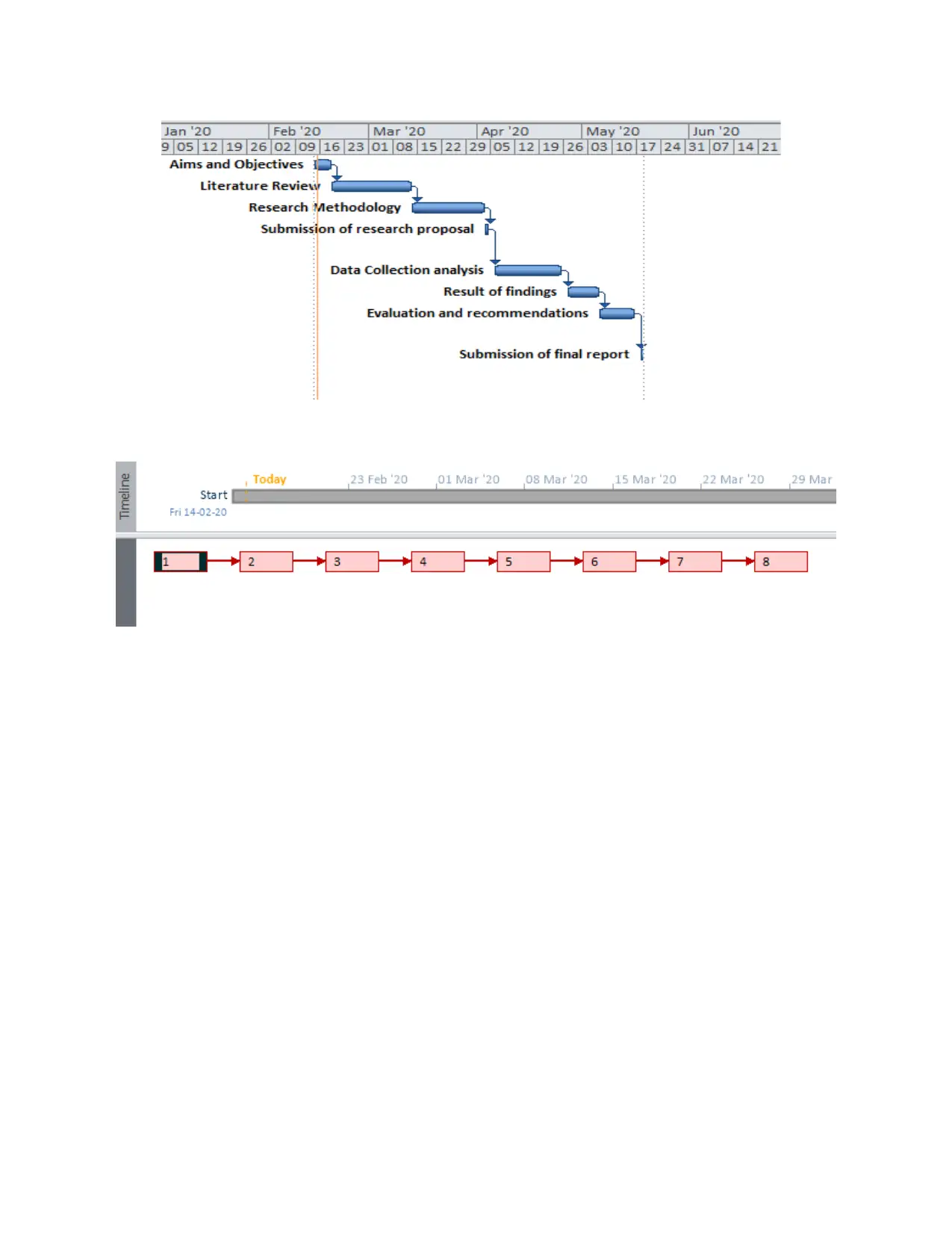
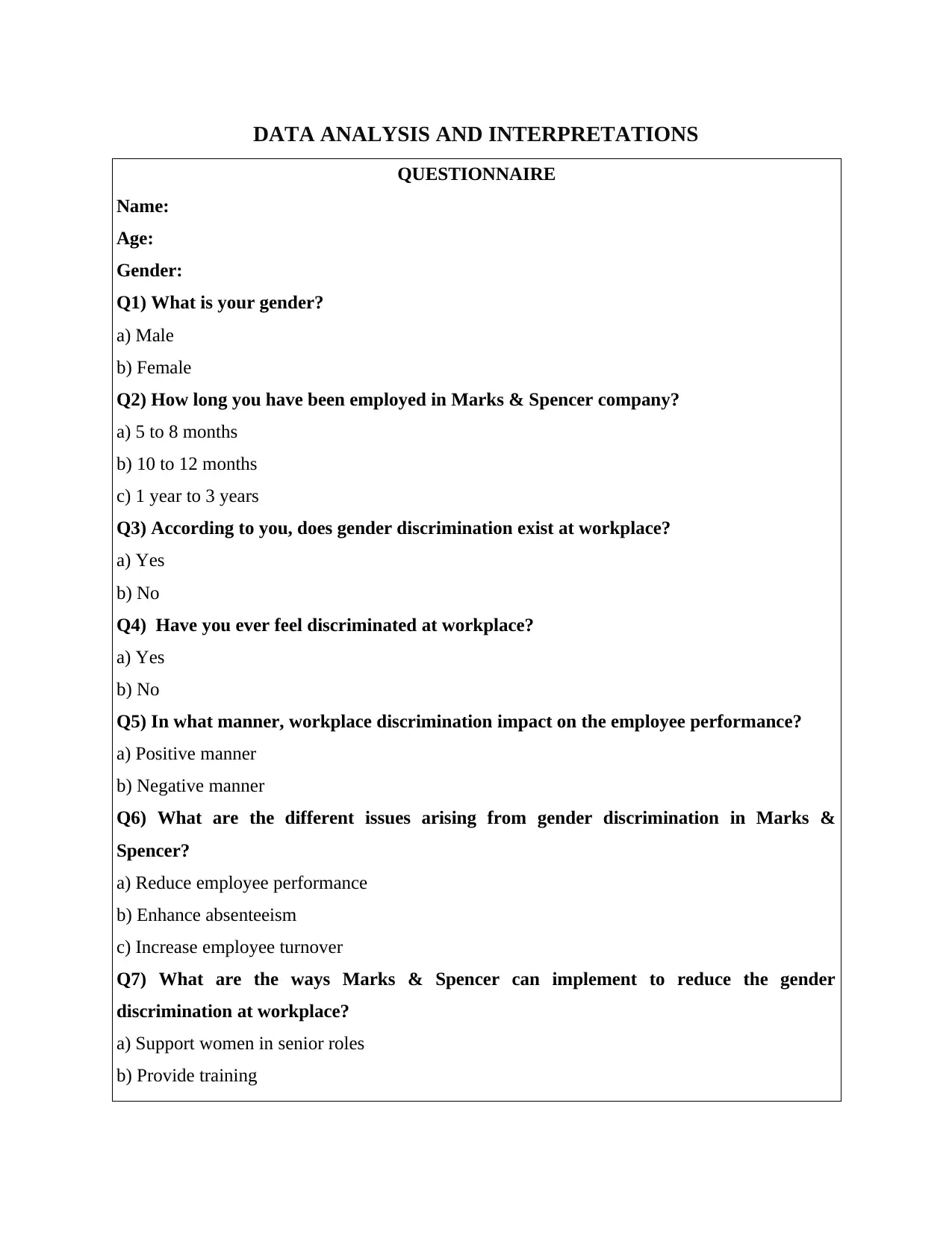
DATA ANALYSIS AND INTERPRETATIONS
QUESTIONNAIRE
Name:
Age:
Gender:
Q1) What is your gender?
a) Male
b) Female
Q2) How long you have been employed in Marks & Spencer company?
a) 5 to 8 months
b) 10 to 12 months
c) 1 year to 3 years
Q3) According to you, does gender discrimination exist at workplace?
a) Yes
b) No
Q4) Have you ever feel discriminated at workplace?
a) Yes
b) No
Q5) In what manner, workplace discrimination impact on the employee performance?
a) Positive manner
b) Negative manner
Q6) What are the different issues arising from gender discrimination in Marks &
Spencer?
a) Reduce employee performance
b) Enhance absenteeism
c) Increase employee turnover
Q7) What are the ways Marks & Spencer can implement to reduce the gender
discrimination at workplace?
a) Support women in senior roles
b) Provide training
QUESTIONNAIRE
Name:
Age:
Gender:
Q1) What is your gender?
a) Male
b) Female
Q2) How long you have been employed in Marks & Spencer company?
a) 5 to 8 months
b) 10 to 12 months
c) 1 year to 3 years
Q3) According to you, does gender discrimination exist at workplace?
a) Yes
b) No
Q4) Have you ever feel discriminated at workplace?
a) Yes
b) No
Q5) In what manner, workplace discrimination impact on the employee performance?
a) Positive manner
b) Negative manner
Q6) What are the different issues arising from gender discrimination in Marks &
Spencer?
a) Reduce employee performance
b) Enhance absenteeism
c) Increase employee turnover
Q7) What are the ways Marks & Spencer can implement to reduce the gender
discrimination at workplace?
a) Support women in senior roles
b) Provide training
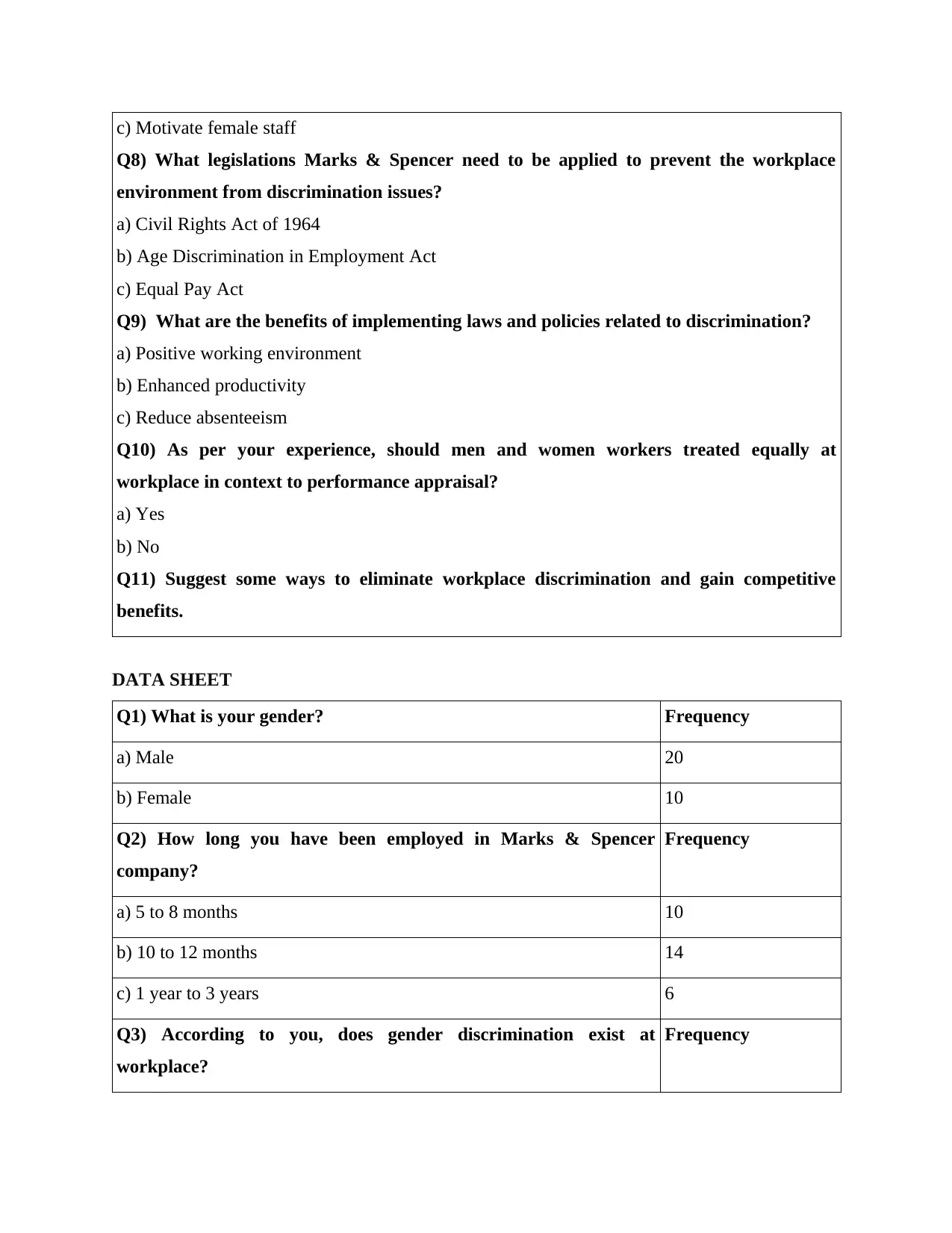
c) Motivate female staff
Q8) What legislations Marks & Spencer need to be applied to prevent the workplace
environment from discrimination issues?
a) Civil Rights Act of 1964
b) Age Discrimination in Employment Act
c) Equal Pay Act
Q9) What are the benefits of implementing laws and policies related to discrimination?
a) Positive working environment
b) Enhanced productivity
c) Reduce absenteeism
Q10) As per your experience, should men and women workers treated equally at
workplace in context to performance appraisal?
a) Yes
b) No
Q11) Suggest some ways to eliminate workplace discrimination and gain competitive
benefits.
DATA SHEET
Q1) What is your gender? Frequency
a) Male 20
b) Female 10
Q2) How long you have been employed in Marks & Spencer
company?
Frequency
a) 5 to 8 months 10
b) 10 to 12 months 14
c) 1 year to 3 years 6
Q3) According to you, does gender discrimination exist at
workplace?
Frequency
Q8) What legislations Marks & Spencer need to be applied to prevent the workplace
environment from discrimination issues?
a) Civil Rights Act of 1964
b) Age Discrimination in Employment Act
c) Equal Pay Act
Q9) What are the benefits of implementing laws and policies related to discrimination?
a) Positive working environment
b) Enhanced productivity
c) Reduce absenteeism
Q10) As per your experience, should men and women workers treated equally at
workplace in context to performance appraisal?
a) Yes
b) No
Q11) Suggest some ways to eliminate workplace discrimination and gain competitive
benefits.
DATA SHEET
Q1) What is your gender? Frequency
a) Male 20
b) Female 10
Q2) How long you have been employed in Marks & Spencer
company?
Frequency
a) 5 to 8 months 10
b) 10 to 12 months 14
c) 1 year to 3 years 6
Q3) According to you, does gender discrimination exist at
workplace?
Frequency
Secure Best Marks with AI Grader
Need help grading? Try our AI Grader for instant feedback on your assignments.
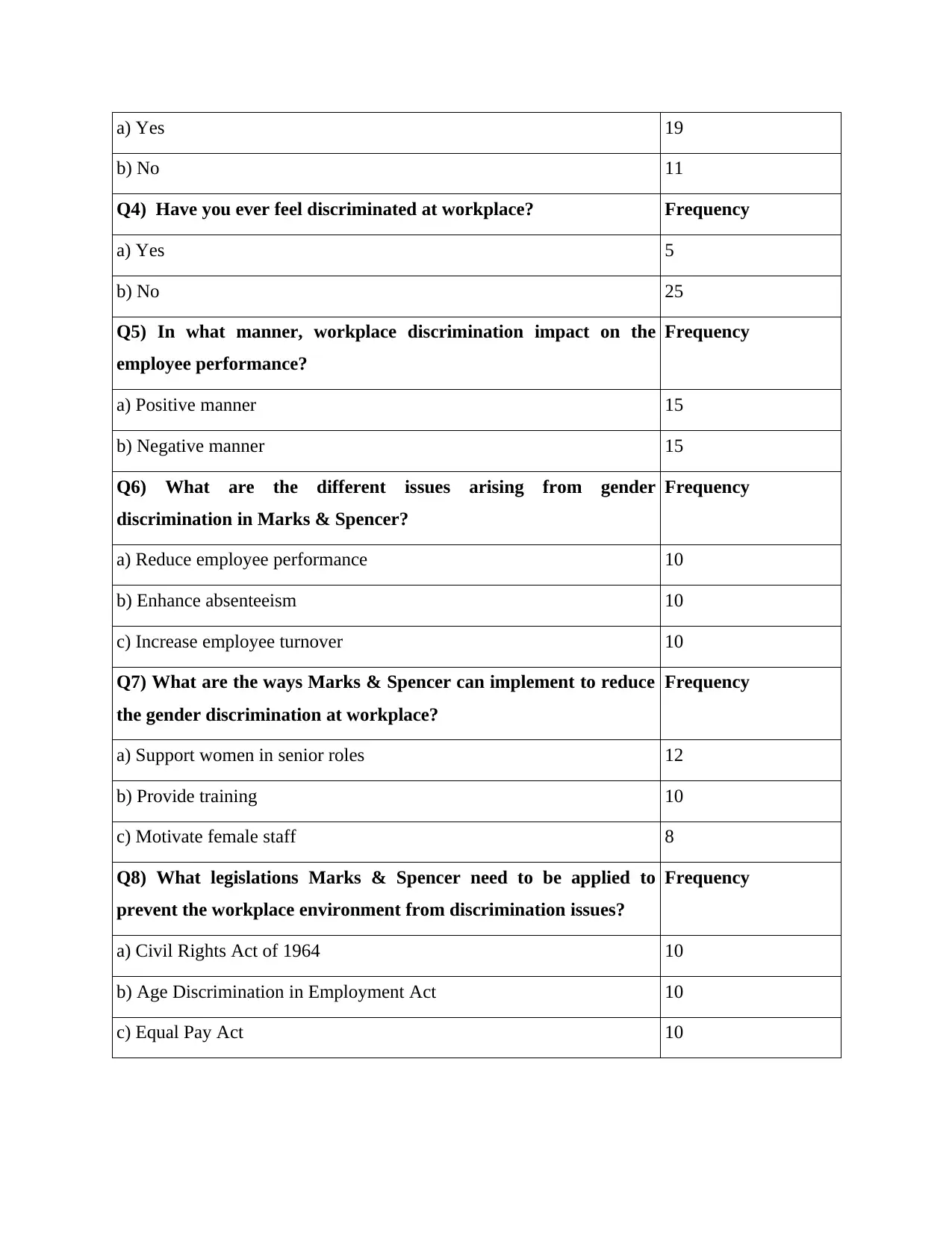
a) Yes 19
b) No 11
Q4) Have you ever feel discriminated at workplace? Frequency
a) Yes 5
b) No 25
Q5) In what manner, workplace discrimination impact on the
employee performance?
Frequency
a) Positive manner 15
b) Negative manner 15
Q6) What are the different issues arising from gender
discrimination in Marks & Spencer?
Frequency
a) Reduce employee performance 10
b) Enhance absenteeism 10
c) Increase employee turnover 10
Q7) What are the ways Marks & Spencer can implement to reduce
the gender discrimination at workplace?
Frequency
a) Support women in senior roles 12
b) Provide training 10
c) Motivate female staff 8
Q8) What legislations Marks & Spencer need to be applied to
prevent the workplace environment from discrimination issues?
Frequency
a) Civil Rights Act of 1964 10
b) Age Discrimination in Employment Act 10
c) Equal Pay Act 10
b) No 11
Q4) Have you ever feel discriminated at workplace? Frequency
a) Yes 5
b) No 25
Q5) In what manner, workplace discrimination impact on the
employee performance?
Frequency
a) Positive manner 15
b) Negative manner 15
Q6) What are the different issues arising from gender
discrimination in Marks & Spencer?
Frequency
a) Reduce employee performance 10
b) Enhance absenteeism 10
c) Increase employee turnover 10
Q7) What are the ways Marks & Spencer can implement to reduce
the gender discrimination at workplace?
Frequency
a) Support women in senior roles 12
b) Provide training 10
c) Motivate female staff 8
Q8) What legislations Marks & Spencer need to be applied to
prevent the workplace environment from discrimination issues?
Frequency
a) Civil Rights Act of 1964 10
b) Age Discrimination in Employment Act 10
c) Equal Pay Act 10
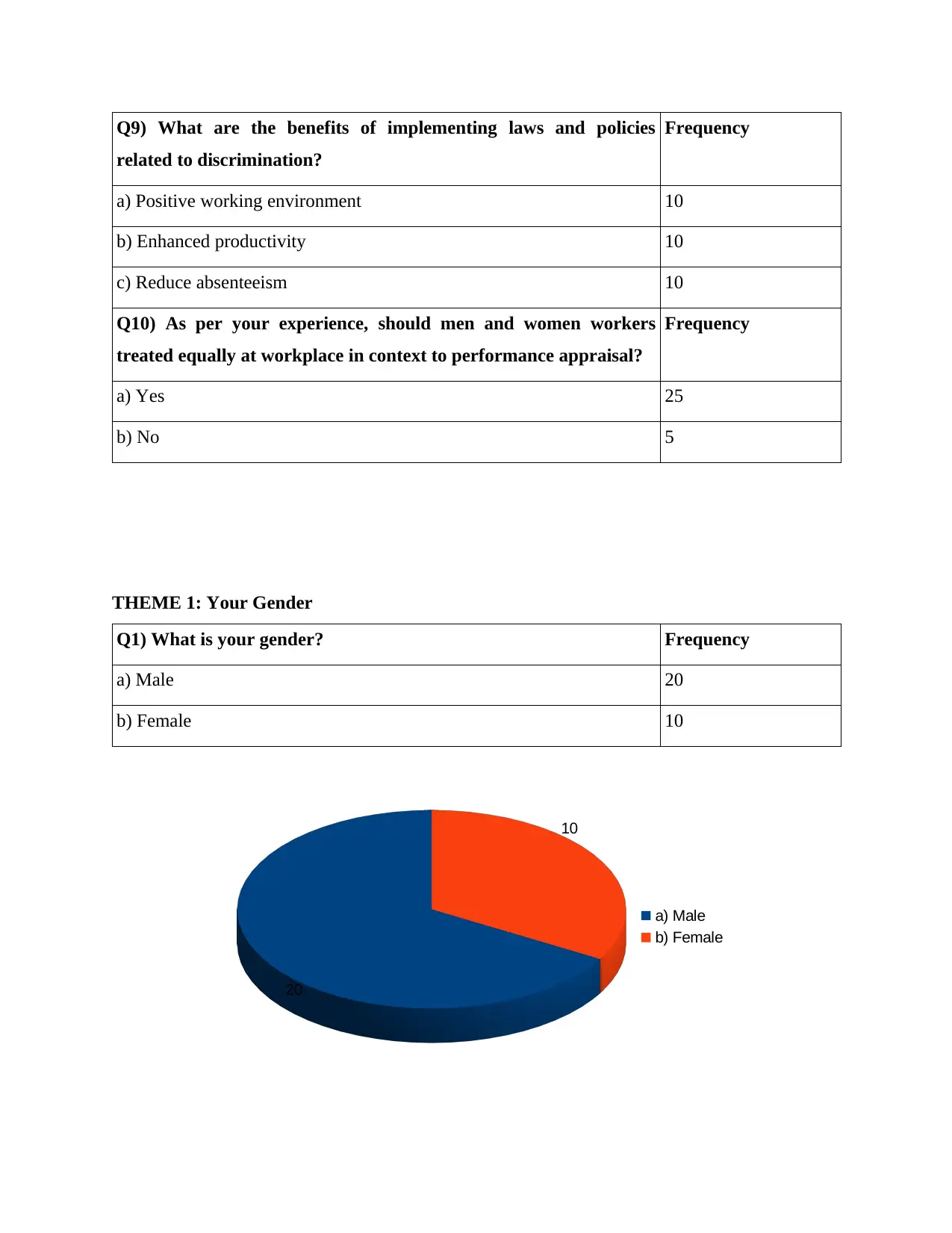
Q9) What are the benefits of implementing laws and policies
related to discrimination?
Frequency
a) Positive working environment 10
b) Enhanced productivity 10
c) Reduce absenteeism 10
Q10) As per your experience, should men and women workers
treated equally at workplace in context to performance appraisal?
Frequency
a) Yes 25
b) No 5
THEME 1: Your Gender
Q1) What is your gender? Frequency
a) Male 20
b) Female 10
20
10
a) Male
b) Female
related to discrimination?
Frequency
a) Positive working environment 10
b) Enhanced productivity 10
c) Reduce absenteeism 10
Q10) As per your experience, should men and women workers
treated equally at workplace in context to performance appraisal?
Frequency
a) Yes 25
b) No 5
THEME 1: Your Gender
Q1) What is your gender? Frequency
a) Male 20
b) Female 10
20
10
a) Male
b) Female
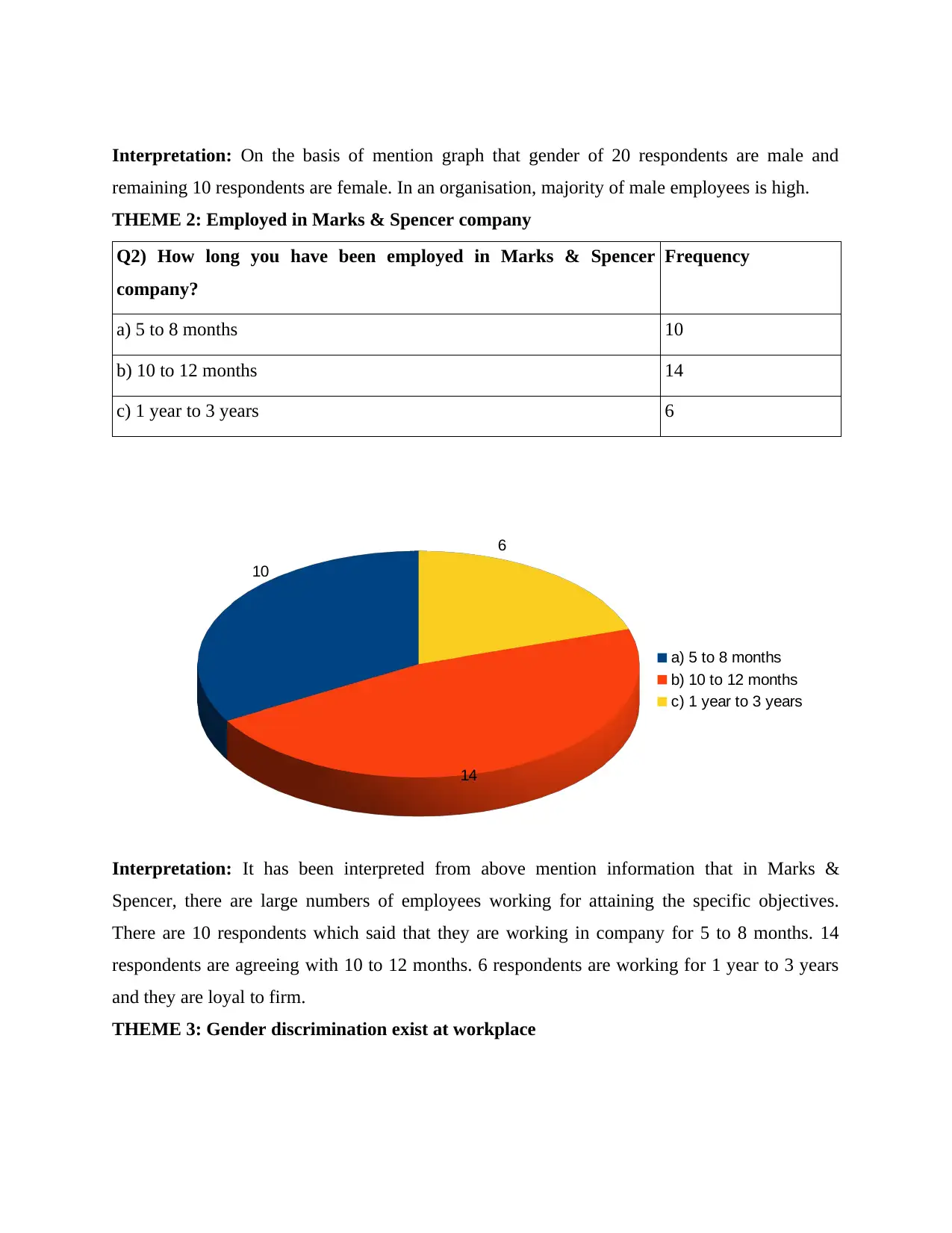
Interpretation: On the basis of mention graph that gender of 20 respondents are male and
remaining 10 respondents are female. In an organisation, majority of male employees is high.
THEME 2: Employed in Marks & Spencer company
Q2) How long you have been employed in Marks & Spencer
company?
Frequency
a) 5 to 8 months 10
b) 10 to 12 months 14
c) 1 year to 3 years 6
Interpretation: It has been interpreted from above mention information that in Marks &
Spencer, there are large numbers of employees working for attaining the specific objectives.
There are 10 respondents which said that they are working in company for 5 to 8 months. 14
respondents are agreeing with 10 to 12 months. 6 respondents are working for 1 year to 3 years
and they are loyal to firm.
THEME 3: Gender discrimination exist at workplace
10
14
6
a) 5 to 8 months
b) 10 to 12 months
c) 1 year to 3 years
remaining 10 respondents are female. In an organisation, majority of male employees is high.
THEME 2: Employed in Marks & Spencer company
Q2) How long you have been employed in Marks & Spencer
company?
Frequency
a) 5 to 8 months 10
b) 10 to 12 months 14
c) 1 year to 3 years 6
Interpretation: It has been interpreted from above mention information that in Marks &
Spencer, there are large numbers of employees working for attaining the specific objectives.
There are 10 respondents which said that they are working in company for 5 to 8 months. 14
respondents are agreeing with 10 to 12 months. 6 respondents are working for 1 year to 3 years
and they are loyal to firm.
THEME 3: Gender discrimination exist at workplace
10
14
6
a) 5 to 8 months
b) 10 to 12 months
c) 1 year to 3 years
Paraphrase This Document
Need a fresh take? Get an instant paraphrase of this document with our AI Paraphraser
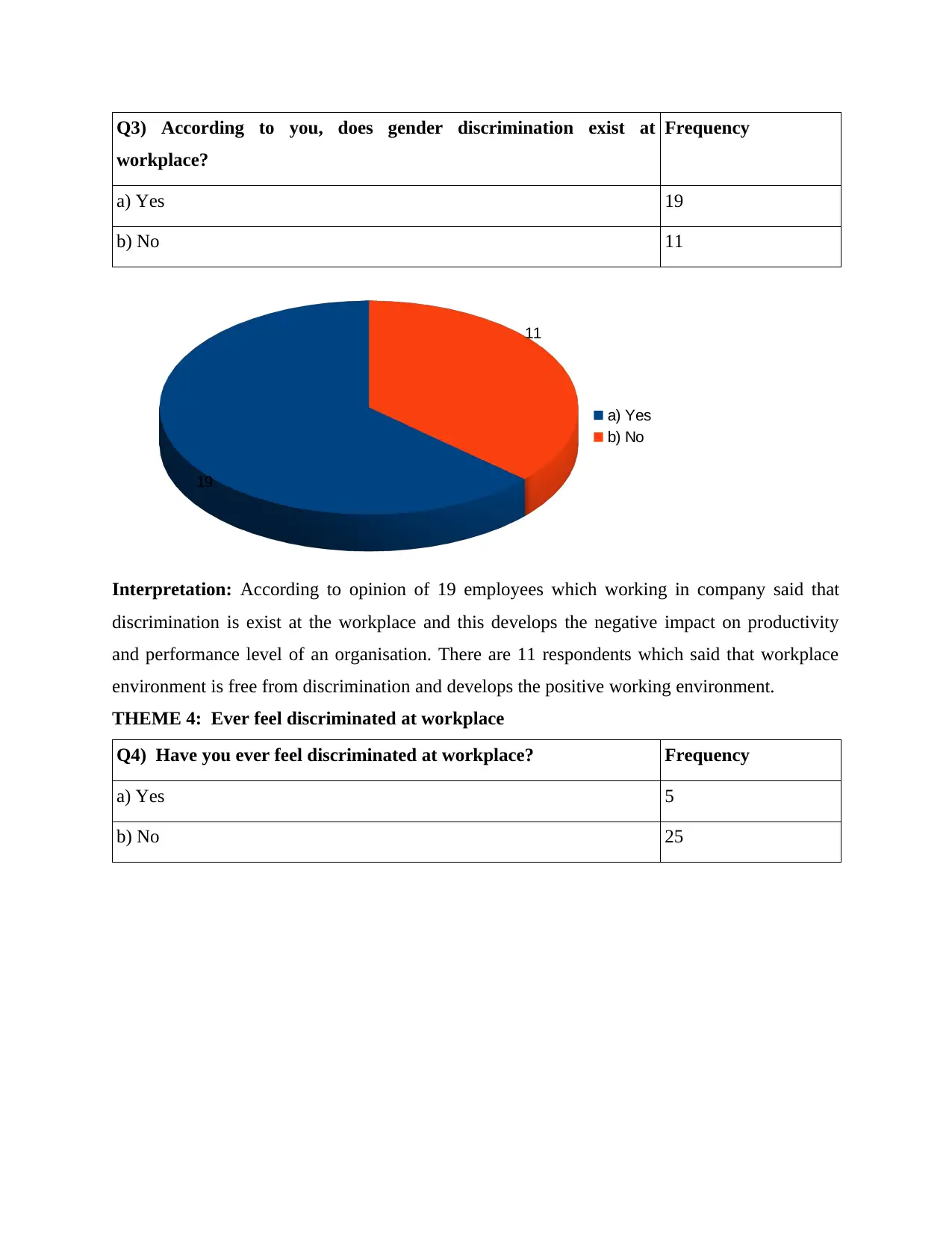
Q3) According to you, does gender discrimination exist at
workplace?
Frequency
a) Yes 19
b) No 11
Interpretation: According to opinion of 19 employees which working in company said that
discrimination is exist at the workplace and this develops the negative impact on productivity
and performance level of an organisation. There are 11 respondents which said that workplace
environment is free from discrimination and develops the positive working environment.
THEME 4: Ever feel discriminated at workplace
Q4) Have you ever feel discriminated at workplace? Frequency
a) Yes 5
b) No 25
19
11
a) Yes
b) No
workplace?
Frequency
a) Yes 19
b) No 11
Interpretation: According to opinion of 19 employees which working in company said that
discrimination is exist at the workplace and this develops the negative impact on productivity
and performance level of an organisation. There are 11 respondents which said that workplace
environment is free from discrimination and develops the positive working environment.
THEME 4: Ever feel discriminated at workplace
Q4) Have you ever feel discriminated at workplace? Frequency
a) Yes 5
b) No 25
19
11
a) Yes
b) No
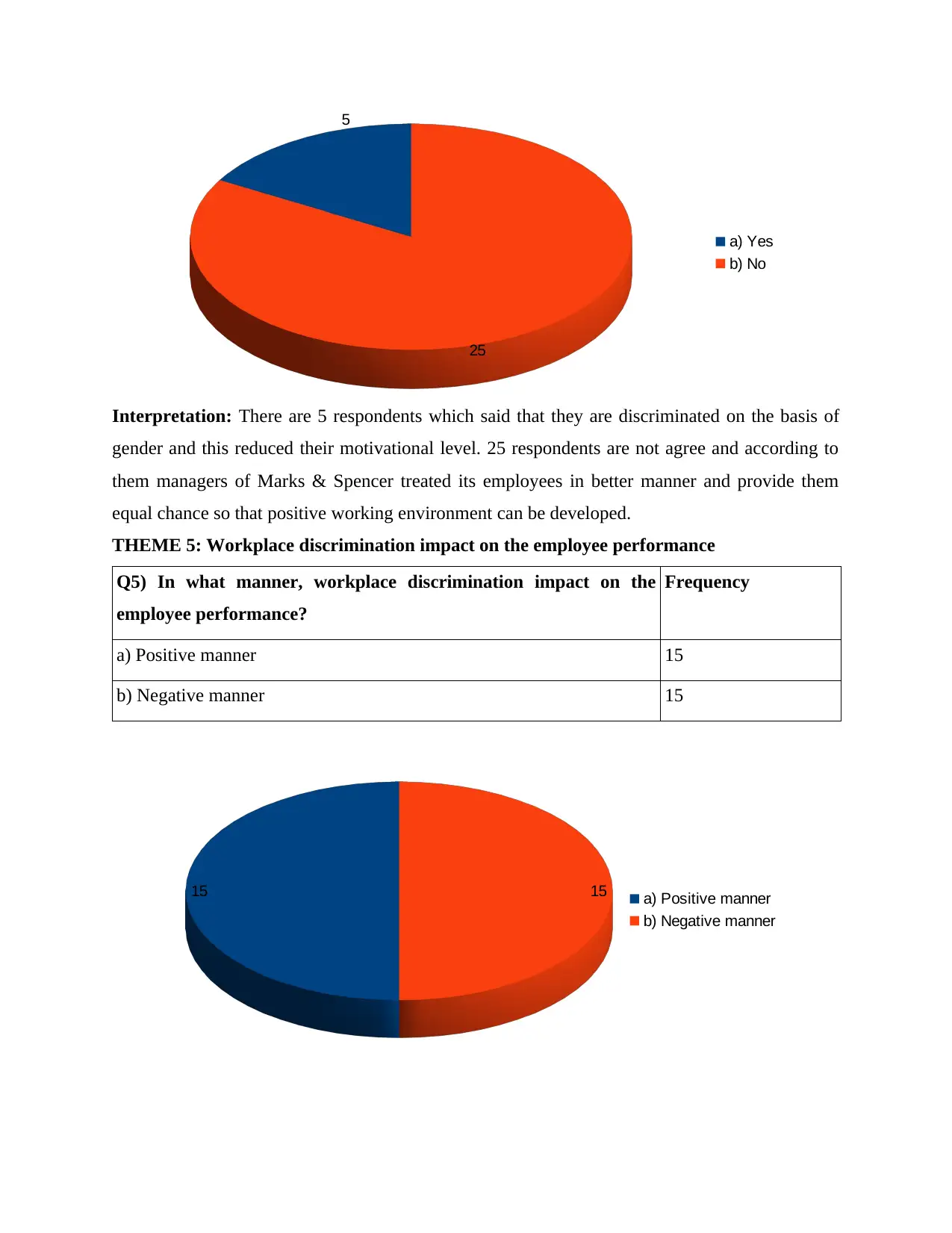
Interpretation: There are 5 respondents which said that they are discriminated on the basis of
gender and this reduced their motivational level. 25 respondents are not agree and according to
them managers of Marks & Spencer treated its employees in better manner and provide them
equal chance so that positive working environment can be developed.
THEME 5: Workplace discrimination impact on the employee performance
Q5) In what manner, workplace discrimination impact on the
employee performance?
Frequency
a) Positive manner 15
b) Negative manner 15
15 15 a) Positive manner
b) Negative manner
5
25
a) Yes
b) No
gender and this reduced their motivational level. 25 respondents are not agree and according to
them managers of Marks & Spencer treated its employees in better manner and provide them
equal chance so that positive working environment can be developed.
THEME 5: Workplace discrimination impact on the employee performance
Q5) In what manner, workplace discrimination impact on the
employee performance?
Frequency
a) Positive manner 15
b) Negative manner 15
15 15 a) Positive manner
b) Negative manner
5
25
a) Yes
b) No
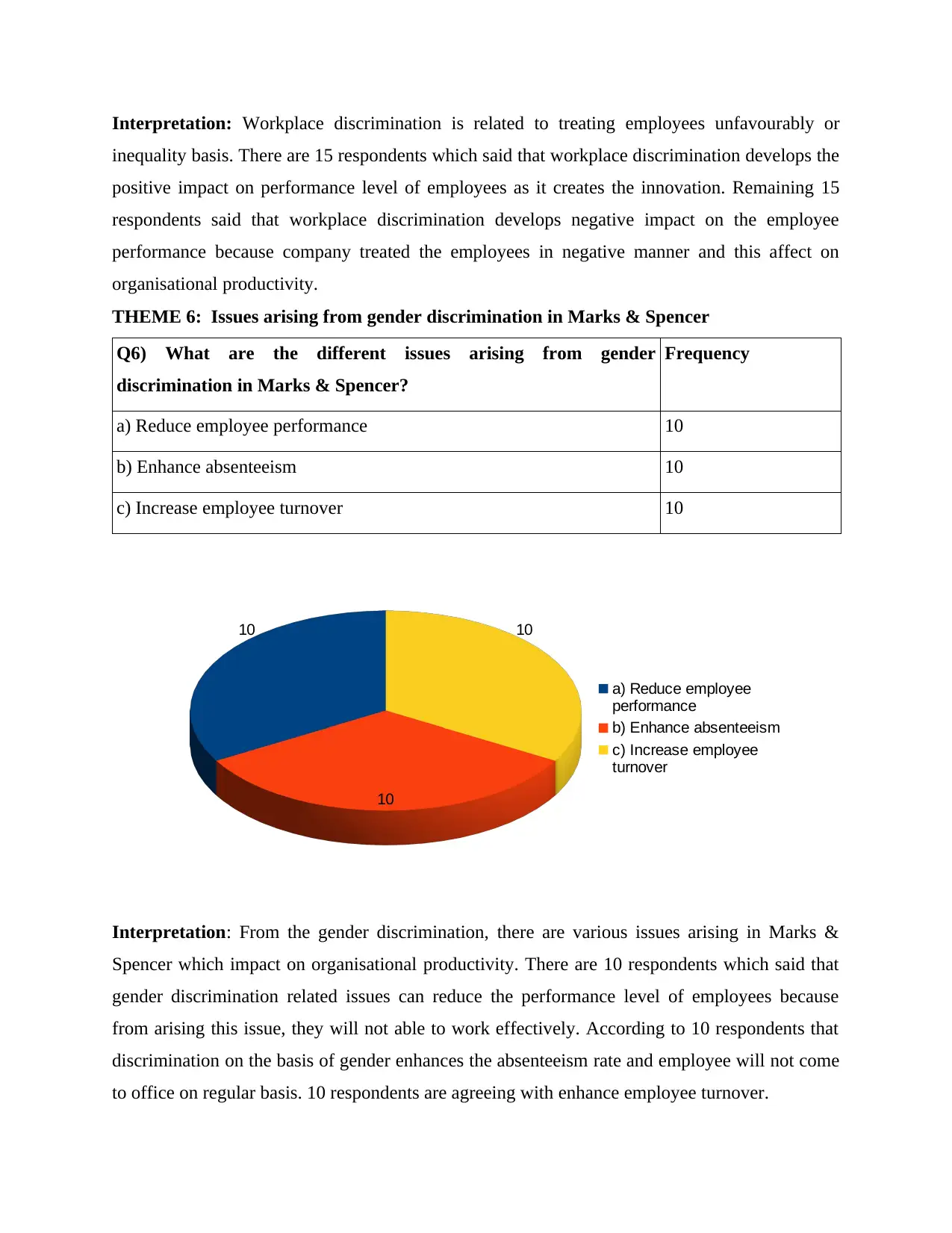
Interpretation: Workplace discrimination is related to treating employees unfavourably or
inequality basis. There are 15 respondents which said that workplace discrimination develops the
positive impact on performance level of employees as it creates the innovation. Remaining 15
respondents said that workplace discrimination develops negative impact on the employee
performance because company treated the employees in negative manner and this affect on
organisational productivity.
THEME 6: Issues arising from gender discrimination in Marks & Spencer
Q6) What are the different issues arising from gender
discrimination in Marks & Spencer?
Frequency
a) Reduce employee performance 10
b) Enhance absenteeism 10
c) Increase employee turnover 10
Interpretation: From the gender discrimination, there are various issues arising in Marks &
Spencer which impact on organisational productivity. There are 10 respondents which said that
gender discrimination related issues can reduce the performance level of employees because
from arising this issue, they will not able to work effectively. According to 10 respondents that
discrimination on the basis of gender enhances the absenteeism rate and employee will not come
to office on regular basis. 10 respondents are agreeing with enhance employee turnover.
10
10
10
a) Reduce employee
performance
b) Enhance absenteeism
c) Increase employee
turnover
inequality basis. There are 15 respondents which said that workplace discrimination develops the
positive impact on performance level of employees as it creates the innovation. Remaining 15
respondents said that workplace discrimination develops negative impact on the employee
performance because company treated the employees in negative manner and this affect on
organisational productivity.
THEME 6: Issues arising from gender discrimination in Marks & Spencer
Q6) What are the different issues arising from gender
discrimination in Marks & Spencer?
Frequency
a) Reduce employee performance 10
b) Enhance absenteeism 10
c) Increase employee turnover 10
Interpretation: From the gender discrimination, there are various issues arising in Marks &
Spencer which impact on organisational productivity. There are 10 respondents which said that
gender discrimination related issues can reduce the performance level of employees because
from arising this issue, they will not able to work effectively. According to 10 respondents that
discrimination on the basis of gender enhances the absenteeism rate and employee will not come
to office on regular basis. 10 respondents are agreeing with enhance employee turnover.
10
10
10
a) Reduce employee
performance
b) Enhance absenteeism
c) Increase employee
turnover
Secure Best Marks with AI Grader
Need help grading? Try our AI Grader for instant feedback on your assignments.
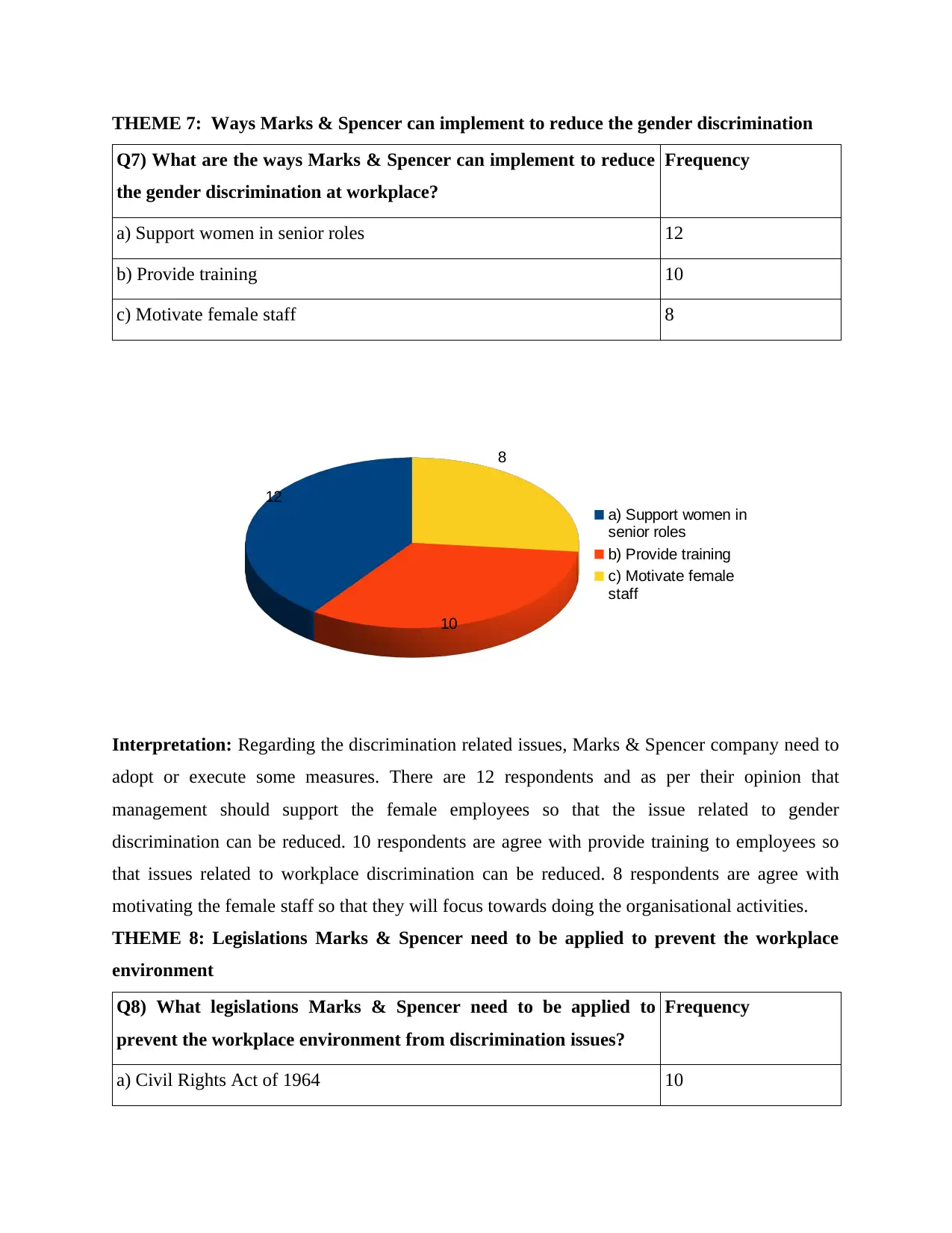
THEME 7: Ways Marks & Spencer can implement to reduce the gender discrimination
Q7) What are the ways Marks & Spencer can implement to reduce
the gender discrimination at workplace?
Frequency
a) Support women in senior roles 12
b) Provide training 10
c) Motivate female staff 8
Interpretation: Regarding the discrimination related issues, Marks & Spencer company need to
adopt or execute some measures. There are 12 respondents and as per their opinion that
management should support the female employees so that the issue related to gender
discrimination can be reduced. 10 respondents are agree with provide training to employees so
that issues related to workplace discrimination can be reduced. 8 respondents are agree with
motivating the female staff so that they will focus towards doing the organisational activities.
THEME 8: Legislations Marks & Spencer need to be applied to prevent the workplace
environment
Q8) What legislations Marks & Spencer need to be applied to
prevent the workplace environment from discrimination issues?
Frequency
a) Civil Rights Act of 1964 10
12
10
8
a) Support women in
senior roles
b) Provide training
c) Motivate female
staff
Q7) What are the ways Marks & Spencer can implement to reduce
the gender discrimination at workplace?
Frequency
a) Support women in senior roles 12
b) Provide training 10
c) Motivate female staff 8
Interpretation: Regarding the discrimination related issues, Marks & Spencer company need to
adopt or execute some measures. There are 12 respondents and as per their opinion that
management should support the female employees so that the issue related to gender
discrimination can be reduced. 10 respondents are agree with provide training to employees so
that issues related to workplace discrimination can be reduced. 8 respondents are agree with
motivating the female staff so that they will focus towards doing the organisational activities.
THEME 8: Legislations Marks & Spencer need to be applied to prevent the workplace
environment
Q8) What legislations Marks & Spencer need to be applied to
prevent the workplace environment from discrimination issues?
Frequency
a) Civil Rights Act of 1964 10
12
10
8
a) Support women in
senior roles
b) Provide training
c) Motivate female
staff
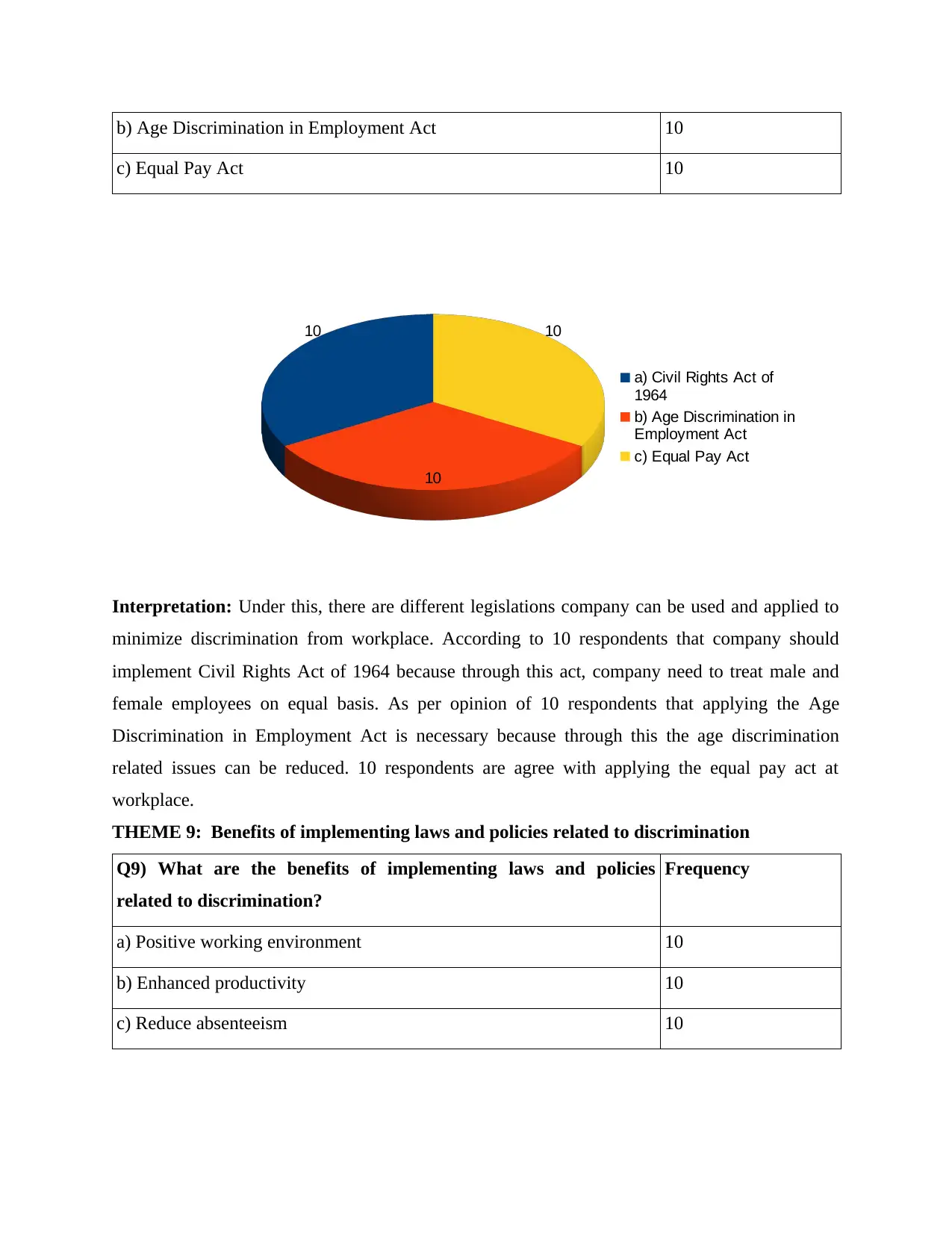
b) Age Discrimination in Employment Act 10
c) Equal Pay Act 10
Interpretation: Under this, there are different legislations company can be used and applied to
minimize discrimination from workplace. According to 10 respondents that company should
implement Civil Rights Act of 1964 because through this act, company need to treat male and
female employees on equal basis. As per opinion of 10 respondents that applying the Age
Discrimination in Employment Act is necessary because through this the age discrimination
related issues can be reduced. 10 respondents are agree with applying the equal pay act at
workplace.
THEME 9: Benefits of implementing laws and policies related to discrimination
Q9) What are the benefits of implementing laws and policies
related to discrimination?
Frequency
a) Positive working environment 10
b) Enhanced productivity 10
c) Reduce absenteeism 10
10
10
10
a) Civil Rights Act of
1964
b) Age Discrimination in
Employment Act
c) Equal Pay Act
c) Equal Pay Act 10
Interpretation: Under this, there are different legislations company can be used and applied to
minimize discrimination from workplace. According to 10 respondents that company should
implement Civil Rights Act of 1964 because through this act, company need to treat male and
female employees on equal basis. As per opinion of 10 respondents that applying the Age
Discrimination in Employment Act is necessary because through this the age discrimination
related issues can be reduced. 10 respondents are agree with applying the equal pay act at
workplace.
THEME 9: Benefits of implementing laws and policies related to discrimination
Q9) What are the benefits of implementing laws and policies
related to discrimination?
Frequency
a) Positive working environment 10
b) Enhanced productivity 10
c) Reduce absenteeism 10
10
10
10
a) Civil Rights Act of
1964
b) Age Discrimination in
Employment Act
c) Equal Pay Act
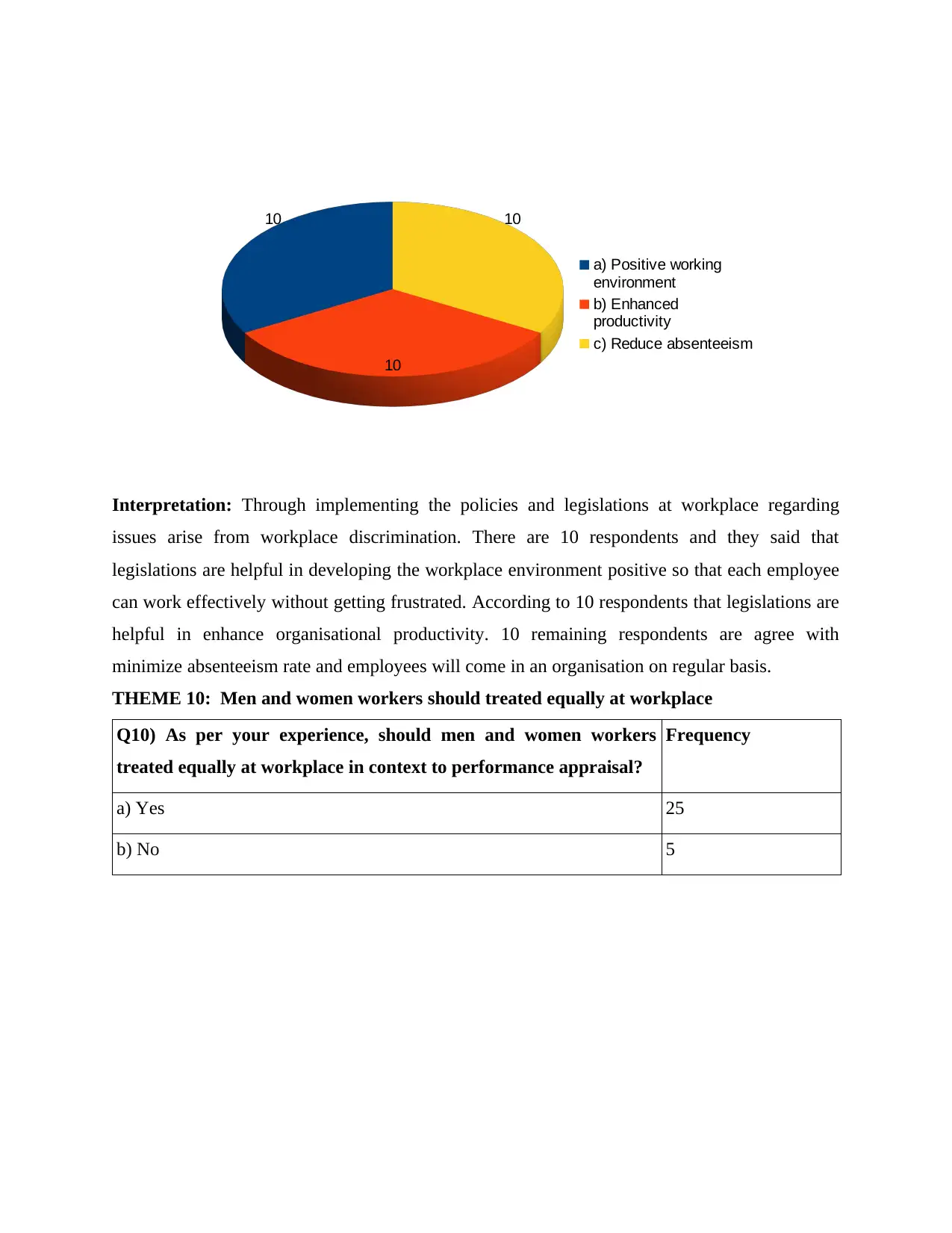
Interpretation: Through implementing the policies and legislations at workplace regarding
issues arise from workplace discrimination. There are 10 respondents and they said that
legislations are helpful in developing the workplace environment positive so that each employee
can work effectively without getting frustrated. According to 10 respondents that legislations are
helpful in enhance organisational productivity. 10 remaining respondents are agree with
minimize absenteeism rate and employees will come in an organisation on regular basis.
THEME 10: Men and women workers should treated equally at workplace
Q10) As per your experience, should men and women workers
treated equally at workplace in context to performance appraisal?
Frequency
a) Yes 25
b) No 5
10
10
10
a) Positive working
environment
b) Enhanced
productivity
c) Reduce absenteeism
issues arise from workplace discrimination. There are 10 respondents and they said that
legislations are helpful in developing the workplace environment positive so that each employee
can work effectively without getting frustrated. According to 10 respondents that legislations are
helpful in enhance organisational productivity. 10 remaining respondents are agree with
minimize absenteeism rate and employees will come in an organisation on regular basis.
THEME 10: Men and women workers should treated equally at workplace
Q10) As per your experience, should men and women workers
treated equally at workplace in context to performance appraisal?
Frequency
a) Yes 25
b) No 5
10
10
10
a) Positive working
environment
b) Enhanced
productivity
c) Reduce absenteeism
Paraphrase This Document
Need a fresh take? Get an instant paraphrase of this document with our AI Paraphraser

Interpretation: In an organisation, opinion of different respondents is different from each other.
There are 25 respondents and as per their opinion that men and women employees at workplace
should be treated on equal basis in related to performance appraisal. 5 respondents are
disagreeing with the given statement and also to them men employees should be on the prior
basis.
25
5
a) Yes
b) No
There are 25 respondents and as per their opinion that men and women employees at workplace
should be treated on equal basis in related to performance appraisal. 5 respondents are
disagreeing with the given statement and also to them men employees should be on the prior
basis.
25
5
a) Yes
b) No
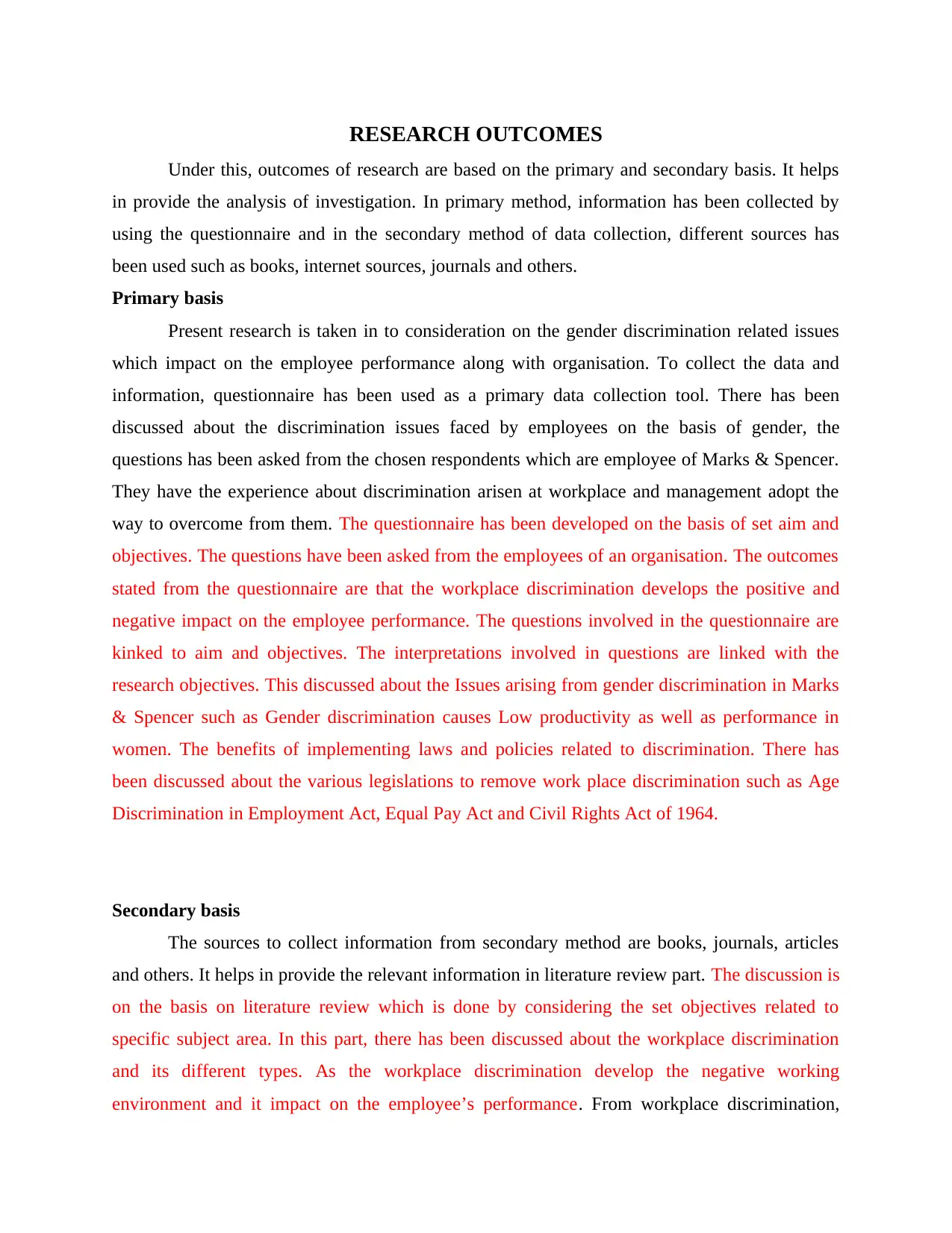
RESEARCH OUTCOMES
Under this, outcomes of research are based on the primary and secondary basis. It helps
in provide the analysis of investigation. In primary method, information has been collected by
using the questionnaire and in the secondary method of data collection, different sources has
been used such as books, internet sources, journals and others.
Primary basis
Present research is taken in to consideration on the gender discrimination related issues
which impact on the employee performance along with organisation. To collect the data and
information, questionnaire has been used as a primary data collection tool. There has been
discussed about the discrimination issues faced by employees on the basis of gender, the
questions has been asked from the chosen respondents which are employee of Marks & Spencer.
They have the experience about discrimination arisen at workplace and management adopt the
way to overcome from them. The questionnaire has been developed on the basis of set aim and
objectives. The questions have been asked from the employees of an organisation. The outcomes
stated from the questionnaire are that the workplace discrimination develops the positive and
negative impact on the employee performance. The questions involved in the questionnaire are
kinked to aim and objectives. The interpretations involved in questions are linked with the
research objectives. This discussed about the Issues arising from gender discrimination in Marks
& Spencer such as Gender discrimination causes Low productivity as well as performance in
women. The benefits of implementing laws and policies related to discrimination. There has
been discussed about the various legislations to remove work place discrimination such as Age
Discrimination in Employment Act, Equal Pay Act and Civil Rights Act of 1964.
Secondary basis
The sources to collect information from secondary method are books, journals, articles
and others. It helps in provide the relevant information in literature review part. The discussion is
on the basis on literature review which is done by considering the set objectives related to
specific subject area. In this part, there has been discussed about the workplace discrimination
and its different types. As the workplace discrimination develop the negative working
environment and it impact on the employee’s performance. From workplace discrimination,
Under this, outcomes of research are based on the primary and secondary basis. It helps
in provide the analysis of investigation. In primary method, information has been collected by
using the questionnaire and in the secondary method of data collection, different sources has
been used such as books, internet sources, journals and others.
Primary basis
Present research is taken in to consideration on the gender discrimination related issues
which impact on the employee performance along with organisation. To collect the data and
information, questionnaire has been used as a primary data collection tool. There has been
discussed about the discrimination issues faced by employees on the basis of gender, the
questions has been asked from the chosen respondents which are employee of Marks & Spencer.
They have the experience about discrimination arisen at workplace and management adopt the
way to overcome from them. The questionnaire has been developed on the basis of set aim and
objectives. The questions have been asked from the employees of an organisation. The outcomes
stated from the questionnaire are that the workplace discrimination develops the positive and
negative impact on the employee performance. The questions involved in the questionnaire are
kinked to aim and objectives. The interpretations involved in questions are linked with the
research objectives. This discussed about the Issues arising from gender discrimination in Marks
& Spencer such as Gender discrimination causes Low productivity as well as performance in
women. The benefits of implementing laws and policies related to discrimination. There has
been discussed about the various legislations to remove work place discrimination such as Age
Discrimination in Employment Act, Equal Pay Act and Civil Rights Act of 1964.
Secondary basis
The sources to collect information from secondary method are books, journals, articles
and others. It helps in provide the relevant information in literature review part. The discussion is
on the basis on literature review which is done by considering the set objectives related to
specific subject area. In this part, there has been discussed about the workplace discrimination
and its different types. As the workplace discrimination develop the negative working
environment and it impact on the employee’s performance. From workplace discrimination,
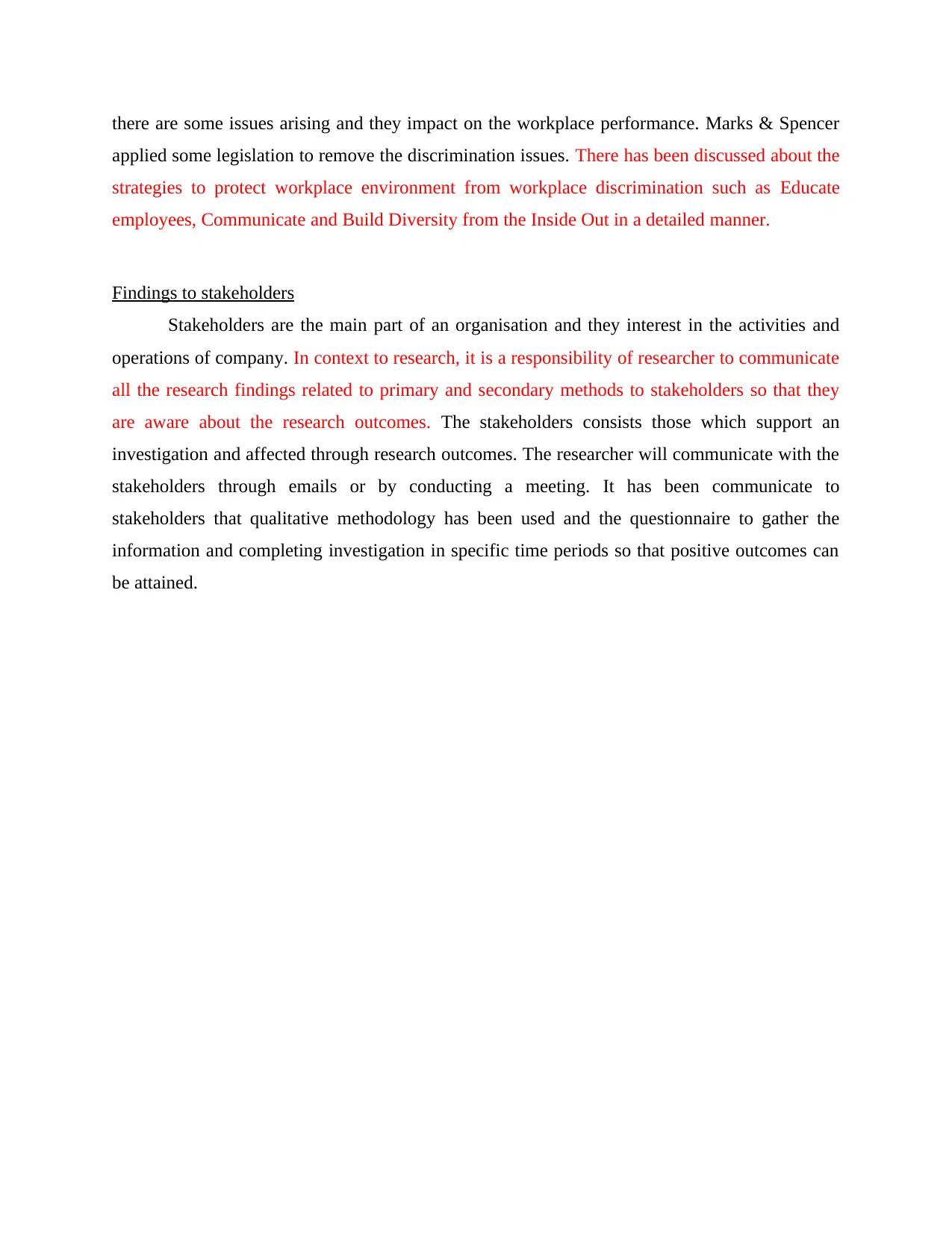
there are some issues arising and they impact on the workplace performance. Marks & Spencer
applied some legislation to remove the discrimination issues. There has been discussed about the
strategies to protect workplace environment from workplace discrimination such as Educate
employees, Communicate and Build Diversity from the Inside Out in a detailed manner.
Findings to stakeholders
Stakeholders are the main part of an organisation and they interest in the activities and
operations of company. In context to research, it is a responsibility of researcher to communicate
all the research findings related to primary and secondary methods to stakeholders so that they
are aware about the research outcomes. The stakeholders consists those which support an
investigation and affected through research outcomes. The researcher will communicate with the
stakeholders through emails or by conducting a meeting. It has been communicate to
stakeholders that qualitative methodology has been used and the questionnaire to gather the
information and completing investigation in specific time periods so that positive outcomes can
be attained.
applied some legislation to remove the discrimination issues. There has been discussed about the
strategies to protect workplace environment from workplace discrimination such as Educate
employees, Communicate and Build Diversity from the Inside Out in a detailed manner.
Findings to stakeholders
Stakeholders are the main part of an organisation and they interest in the activities and
operations of company. In context to research, it is a responsibility of researcher to communicate
all the research findings related to primary and secondary methods to stakeholders so that they
are aware about the research outcomes. The stakeholders consists those which support an
investigation and affected through research outcomes. The researcher will communicate with the
stakeholders through emails or by conducting a meeting. It has been communicate to
stakeholders that qualitative methodology has been used and the questionnaire to gather the
information and completing investigation in specific time periods so that positive outcomes can
be attained.
Secure Best Marks with AI Grader
Need help grading? Try our AI Grader for instant feedback on your assignments.
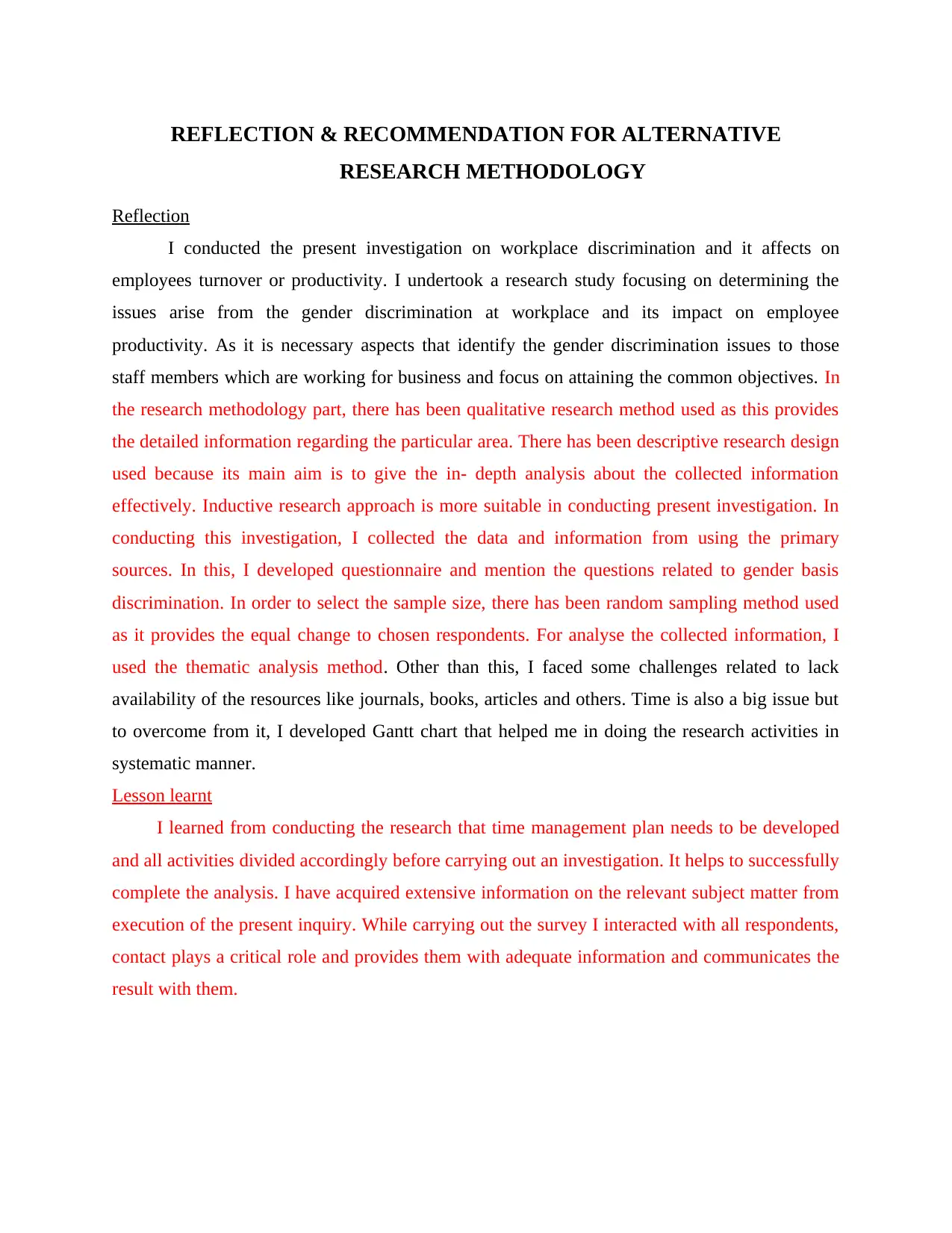
REFLECTION & RECOMMENDATION FOR ALTERNATIVE
RESEARCH METHODOLOGY
Reflection
I conducted the present investigation on workplace discrimination and it affects on
employees turnover or productivity. I undertook a research study focusing on determining the
issues arise from the gender discrimination at workplace and its impact on employee
productivity. As it is necessary aspects that identify the gender discrimination issues to those
staff members which are working for business and focus on attaining the common objectives. In
the research methodology part, there has been qualitative research method used as this provides
the detailed information regarding the particular area. There has been descriptive research design
used because its main aim is to give the in- depth analysis about the collected information
effectively. Inductive research approach is more suitable in conducting present investigation. In
conducting this investigation, I collected the data and information from using the primary
sources. In this, I developed questionnaire and mention the questions related to gender basis
discrimination. In order to select the sample size, there has been random sampling method used
as it provides the equal change to chosen respondents. For analyse the collected information, I
used the thematic analysis method. Other than this, I faced some challenges related to lack
availability of the resources like journals, books, articles and others. Time is also a big issue but
to overcome from it, I developed Gantt chart that helped me in doing the research activities in
systematic manner.
Lesson learnt
I learned from conducting the research that time management plan needs to be developed
and all activities divided accordingly before carrying out an investigation. It helps to successfully
complete the analysis. I have acquired extensive information on the relevant subject matter from
execution of the present inquiry. While carrying out the survey I interacted with all respondents,
contact plays a critical role and provides them with adequate information and communicates the
result with them.
RESEARCH METHODOLOGY
Reflection
I conducted the present investigation on workplace discrimination and it affects on
employees turnover or productivity. I undertook a research study focusing on determining the
issues arise from the gender discrimination at workplace and its impact on employee
productivity. As it is necessary aspects that identify the gender discrimination issues to those
staff members which are working for business and focus on attaining the common objectives. In
the research methodology part, there has been qualitative research method used as this provides
the detailed information regarding the particular area. There has been descriptive research design
used because its main aim is to give the in- depth analysis about the collected information
effectively. Inductive research approach is more suitable in conducting present investigation. In
conducting this investigation, I collected the data and information from using the primary
sources. In this, I developed questionnaire and mention the questions related to gender basis
discrimination. In order to select the sample size, there has been random sampling method used
as it provides the equal change to chosen respondents. For analyse the collected information, I
used the thematic analysis method. Other than this, I faced some challenges related to lack
availability of the resources like journals, books, articles and others. Time is also a big issue but
to overcome from it, I developed Gantt chart that helped me in doing the research activities in
systematic manner.
Lesson learnt
I learned from conducting the research that time management plan needs to be developed
and all activities divided accordingly before carrying out an investigation. It helps to successfully
complete the analysis. I have acquired extensive information on the relevant subject matter from
execution of the present inquiry. While carrying out the survey I interacted with all respondents,
contact plays a critical role and provides them with adequate information and communicates the
result with them.
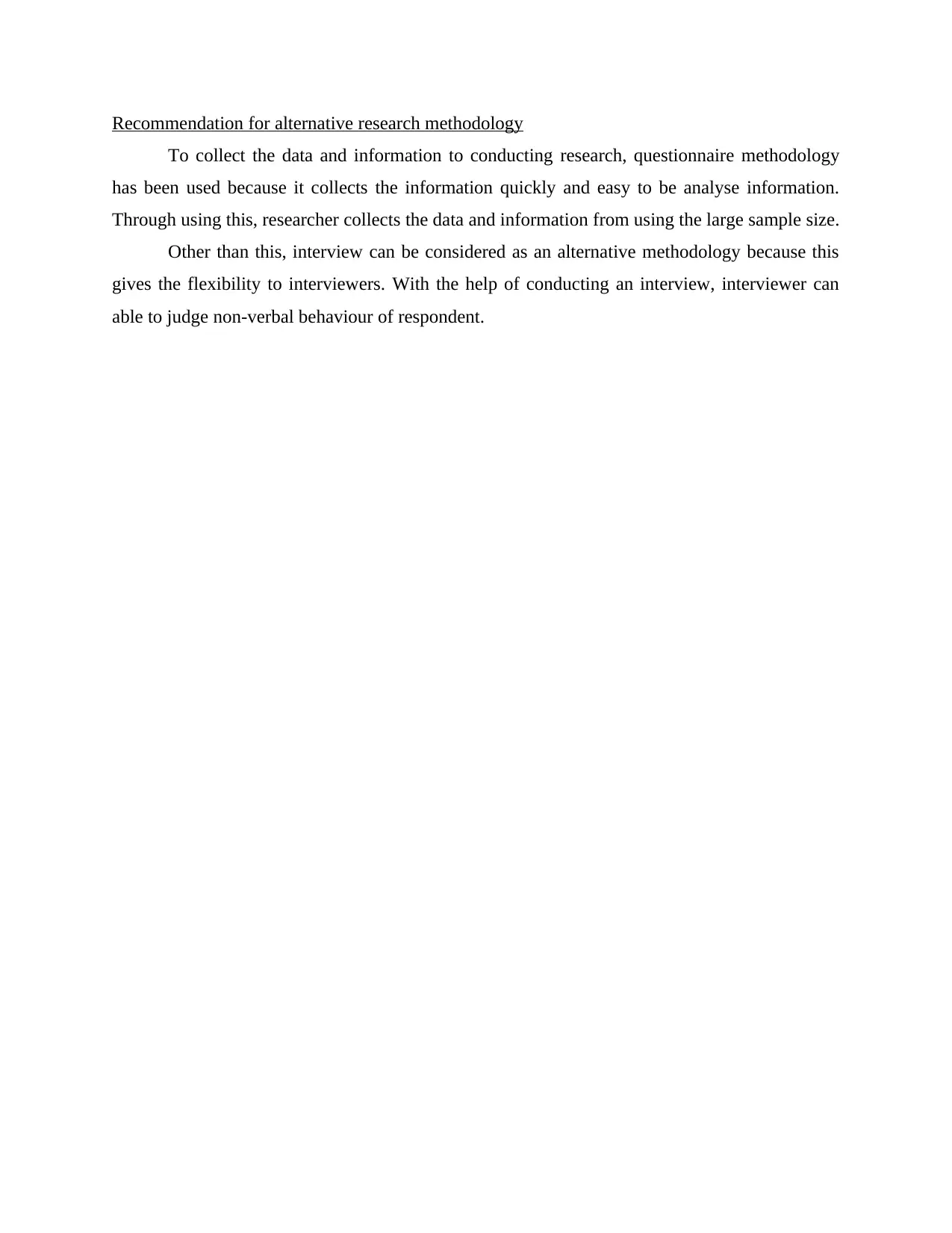
Recommendation for alternative research methodology
To collect the data and information to conducting research, questionnaire methodology
has been used because it collects the information quickly and easy to be analyse information.
Through using this, researcher collects the data and information from using the large sample size.
Other than this, interview can be considered as an alternative methodology because this
gives the flexibility to interviewers. With the help of conducting an interview, interviewer can
able to judge non-verbal behaviour of respondent.
To collect the data and information to conducting research, questionnaire methodology
has been used because it collects the information quickly and easy to be analyse information.
Through using this, researcher collects the data and information from using the large sample size.
Other than this, interview can be considered as an alternative methodology because this
gives the flexibility to interviewers. With the help of conducting an interview, interviewer can
able to judge non-verbal behaviour of respondent.

CONCLUSION
It has been concluded from above mention report that discrimination at workplace
develops the positive and negative impact on employee’s performance and turnover. There has
been discussed about the issues arising from the gender basis discrimination at workplace in
literature review part. To collect information, primary and secondary both methods has been
used. In doing literature review part, secondary method has been used. To collect information by
using primary method, questionnaire has been developed. Under this, there has been discussed
about strategies which mainly used to overcome from the arisen issues from gender
discrimination at workplace.
RECOMMENDATIONS
Present report is taken into consideration on impact of workplace discrimination on the
basis of gender. It impacts on the employee performance as well as turnover. There are some
recommendations mention below:
Under this, Firm require to determined the discrimination issue arise at workplace.
Marks & Spencer should motivate its female staff so that they can focus on attaining
specific objectives.
Company should provide the training to employees about prevent the workplace
environment from discrimination.
Manager should treat the male and female employees on equal basis so that the
workplace environment can be positively developed.
It has been concluded from above mention report that discrimination at workplace
develops the positive and negative impact on employee’s performance and turnover. There has
been discussed about the issues arising from the gender basis discrimination at workplace in
literature review part. To collect information, primary and secondary both methods has been
used. In doing literature review part, secondary method has been used. To collect information by
using primary method, questionnaire has been developed. Under this, there has been discussed
about strategies which mainly used to overcome from the arisen issues from gender
discrimination at workplace.
RECOMMENDATIONS
Present report is taken into consideration on impact of workplace discrimination on the
basis of gender. It impacts on the employee performance as well as turnover. There are some
recommendations mention below:
Under this, Firm require to determined the discrimination issue arise at workplace.
Marks & Spencer should motivate its female staff so that they can focus on attaining
specific objectives.
Company should provide the training to employees about prevent the workplace
environment from discrimination.
Manager should treat the male and female employees on equal basis so that the
workplace environment can be positively developed.
Paraphrase This Document
Need a fresh take? Get an instant paraphrase of this document with our AI Paraphraser
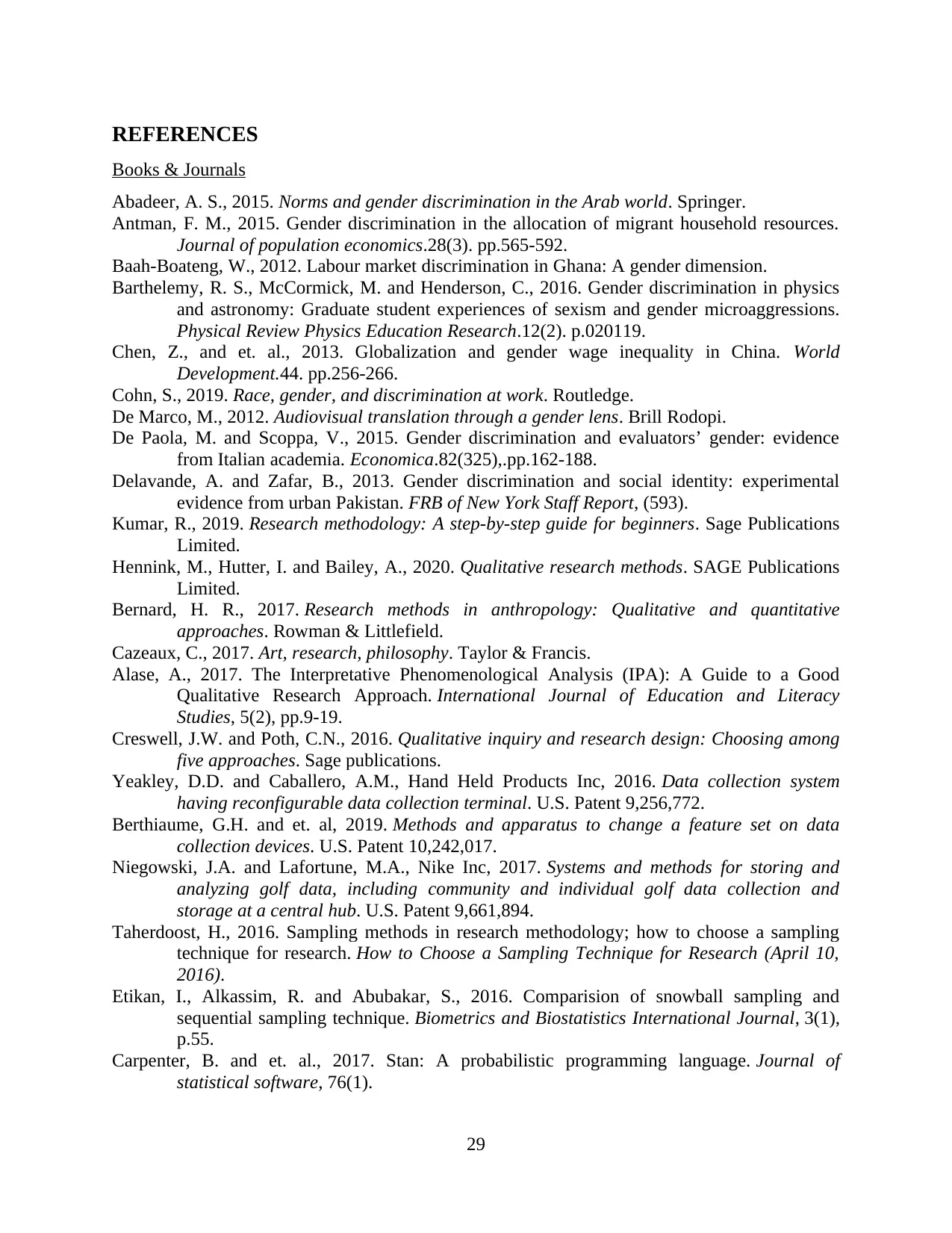
REFERENCES
Books & Journals
Abadeer, A. S., 2015. Norms and gender discrimination in the Arab world. Springer.
Antman, F. M., 2015. Gender discrimination in the allocation of migrant household resources.
Journal of population economics.28(3). pp.565-592.
Baah-Boateng, W., 2012. Labour market discrimination in Ghana: A gender dimension.
Barthelemy, R. S., McCormick, M. and Henderson, C., 2016. Gender discrimination in physics
and astronomy: Graduate student experiences of sexism and gender microaggressions.
Physical Review Physics Education Research.12(2). p.020119.
Chen, Z., and et. al., 2013. Globalization and gender wage inequality in China. World
Development.44. pp.256-266.
Cohn, S., 2019. Race, gender, and discrimination at work. Routledge.
De Marco, M., 2012. Audiovisual translation through a gender lens. Brill Rodopi.
De Paola, M. and Scoppa, V., 2015. Gender discrimination and evaluators’ gender: evidence
from Italian academia. Economica.82(325),.pp.162-188.
Delavande, A. and Zafar, B., 2013. Gender discrimination and social identity: experimental
evidence from urban Pakistan. FRB of New York Staff Report, (593).
Kumar, R., 2019. Research methodology: A step-by-step guide for beginners. Sage Publications
Limited.
Hennink, M., Hutter, I. and Bailey, A., 2020. Qualitative research methods. SAGE Publications
Limited.
Bernard, H. R., 2017. Research methods in anthropology: Qualitative and quantitative
approaches. Rowman & Littlefield.
Cazeaux, C., 2017. Art, research, philosophy. Taylor & Francis.
Alase, A., 2017. The Interpretative Phenomenological Analysis (IPA): A Guide to a Good
Qualitative Research Approach. International Journal of Education and Literacy
Studies, 5(2), pp.9-19.
Creswell, J.W. and Poth, C.N., 2016. Qualitative inquiry and research design: Choosing among
five approaches. Sage publications.
Yeakley, D.D. and Caballero, A.M., Hand Held Products Inc, 2016. Data collection system
having reconfigurable data collection terminal. U.S. Patent 9,256,772.
Berthiaume, G.H. and et. al, 2019. Methods and apparatus to change a feature set on data
collection devices. U.S. Patent 10,242,017.
Niegowski, J.A. and Lafortune, M.A., Nike Inc, 2017. Systems and methods for storing and
analyzing golf data, including community and individual golf data collection and
storage at a central hub. U.S. Patent 9,661,894.
Taherdoost, H., 2016. Sampling methods in research methodology; how to choose a sampling
technique for research. How to Choose a Sampling Technique for Research (April 10,
2016).
Etikan, I., Alkassim, R. and Abubakar, S., 2016. Comparision of snowball sampling and
sequential sampling technique. Biometrics and Biostatistics International Journal, 3(1),
p.55.
Carpenter, B. and et. al., 2017. Stan: A probabilistic programming language. Journal of
statistical software, 76(1).
29
Books & Journals
Abadeer, A. S., 2015. Norms and gender discrimination in the Arab world. Springer.
Antman, F. M., 2015. Gender discrimination in the allocation of migrant household resources.
Journal of population economics.28(3). pp.565-592.
Baah-Boateng, W., 2012. Labour market discrimination in Ghana: A gender dimension.
Barthelemy, R. S., McCormick, M. and Henderson, C., 2016. Gender discrimination in physics
and astronomy: Graduate student experiences of sexism and gender microaggressions.
Physical Review Physics Education Research.12(2). p.020119.
Chen, Z., and et. al., 2013. Globalization and gender wage inequality in China. World
Development.44. pp.256-266.
Cohn, S., 2019. Race, gender, and discrimination at work. Routledge.
De Marco, M., 2012. Audiovisual translation through a gender lens. Brill Rodopi.
De Paola, M. and Scoppa, V., 2015. Gender discrimination and evaluators’ gender: evidence
from Italian academia. Economica.82(325),.pp.162-188.
Delavande, A. and Zafar, B., 2013. Gender discrimination and social identity: experimental
evidence from urban Pakistan. FRB of New York Staff Report, (593).
Kumar, R., 2019. Research methodology: A step-by-step guide for beginners. Sage Publications
Limited.
Hennink, M., Hutter, I. and Bailey, A., 2020. Qualitative research methods. SAGE Publications
Limited.
Bernard, H. R., 2017. Research methods in anthropology: Qualitative and quantitative
approaches. Rowman & Littlefield.
Cazeaux, C., 2017. Art, research, philosophy. Taylor & Francis.
Alase, A., 2017. The Interpretative Phenomenological Analysis (IPA): A Guide to a Good
Qualitative Research Approach. International Journal of Education and Literacy
Studies, 5(2), pp.9-19.
Creswell, J.W. and Poth, C.N., 2016. Qualitative inquiry and research design: Choosing among
five approaches. Sage publications.
Yeakley, D.D. and Caballero, A.M., Hand Held Products Inc, 2016. Data collection system
having reconfigurable data collection terminal. U.S. Patent 9,256,772.
Berthiaume, G.H. and et. al, 2019. Methods and apparatus to change a feature set on data
collection devices. U.S. Patent 10,242,017.
Niegowski, J.A. and Lafortune, M.A., Nike Inc, 2017. Systems and methods for storing and
analyzing golf data, including community and individual golf data collection and
storage at a central hub. U.S. Patent 9,661,894.
Taherdoost, H., 2016. Sampling methods in research methodology; how to choose a sampling
technique for research. How to Choose a Sampling Technique for Research (April 10,
2016).
Etikan, I., Alkassim, R. and Abubakar, S., 2016. Comparision of snowball sampling and
sequential sampling technique. Biometrics and Biostatistics International Journal, 3(1),
p.55.
Carpenter, B. and et. al., 2017. Stan: A probabilistic programming language. Journal of
statistical software, 76(1).
29

Kearns, K.P., 2020, June. Moral and Ethical Considerations…. In Seminars in Speech and
Language (Vol. 41, No. 03, pp. 209-211). Thieme Medical Publishers.
Online
Benstead, S., 2020. What is discrimination in the workplace?. [Online]. Available through:
<https://www.breathehr.com/blog/what-is-discrimination-in-the-workplace>.
COX, J., 2018. Marks & Spencer admits to 12.3% gender pay gap. [Online]. Available through:
<https://www.independent.co.uk/news/business/news/marks-and-spencer-gender-pay-
gap-staff-reporting-women-less-men-a8230751.html>.
Jeanetta, T., 2019. 7 Ways to Reduce Gender Discrimination in Your Workplace. [Online].
Available through: <https://theolsongroup.com/knock-down-gender-barriers/>.
Valfort, M. A., 2020. Do anti-discrimination policies work?. [Online]. Available through:
<https://wol.iza.org/articles/do-anti-discrimination-policies-work/long>.
30
Language (Vol. 41, No. 03, pp. 209-211). Thieme Medical Publishers.
Online
Benstead, S., 2020. What is discrimination in the workplace?. [Online]. Available through:
<https://www.breathehr.com/blog/what-is-discrimination-in-the-workplace>.
COX, J., 2018. Marks & Spencer admits to 12.3% gender pay gap. [Online]. Available through:
<https://www.independent.co.uk/news/business/news/marks-and-spencer-gender-pay-
gap-staff-reporting-women-less-men-a8230751.html>.
Jeanetta, T., 2019. 7 Ways to Reduce Gender Discrimination in Your Workplace. [Online].
Available through: <https://theolsongroup.com/knock-down-gender-barriers/>.
Valfort, M. A., 2020. Do anti-discrimination policies work?. [Online]. Available through:
<https://wol.iza.org/articles/do-anti-discrimination-policies-work/long>.
30
1 out of 33
Related Documents
Your All-in-One AI-Powered Toolkit for Academic Success.
+13062052269
info@desklib.com
Available 24*7 on WhatsApp / Email
![[object Object]](/_next/static/media/star-bottom.7253800d.svg)
Unlock your academic potential
© 2024 | Zucol Services PVT LTD | All rights reserved.




